
Lake Elmenteita, Kenya. (LUO HONG)
Every time the sun comes up, myriads of animals, plants, and microbes on this planet welcome it alongside us. Regardless of size and shape, every life is valuable. Terrestrial, marine, and other aquatic ecosystems, as well as the ecological complexes they populate, constitute biodiversity, which is the material basis for human subsistence. They provide people with not just food, medicine, and energy, but also cultural and spiritual support.
However, the Earth is ringing alarm bells: Massive loss of forests and wetlands has pushed millions of species to the brink of extinction as persistent challenges thwart global biodiversity conservation. This degradation seriously threatens the survival of future generations, increases the risk of disease outbreak, and impedes achievement of sustainable development goals.
The United Nations General Assembly has scheduled a Summit on Biodiversity for September 30, 2020, during its 75th Session. Although countries around the world are still focused on battling the unrelenting COVID-19 pandemic while grasping for post-pandemic recovery, biodiversity conservation remains a pressing issue. From nature-based solutions to climate, food, water security, and sustainable livelihood, biodiversity issues are essential if we are to ever approach sustainable development.
The COVID-19 outbreak inspired widespread reflection on the relationship between man and nature and prompted new work to find methods to protect biodiversity, reduce the risk of future pandemics, and build an Earth community striving for a better future.
SAVING GLOBAL SPECIES
We are facing a major opportunity to bring nature back from the brink
By Yuan Yanan
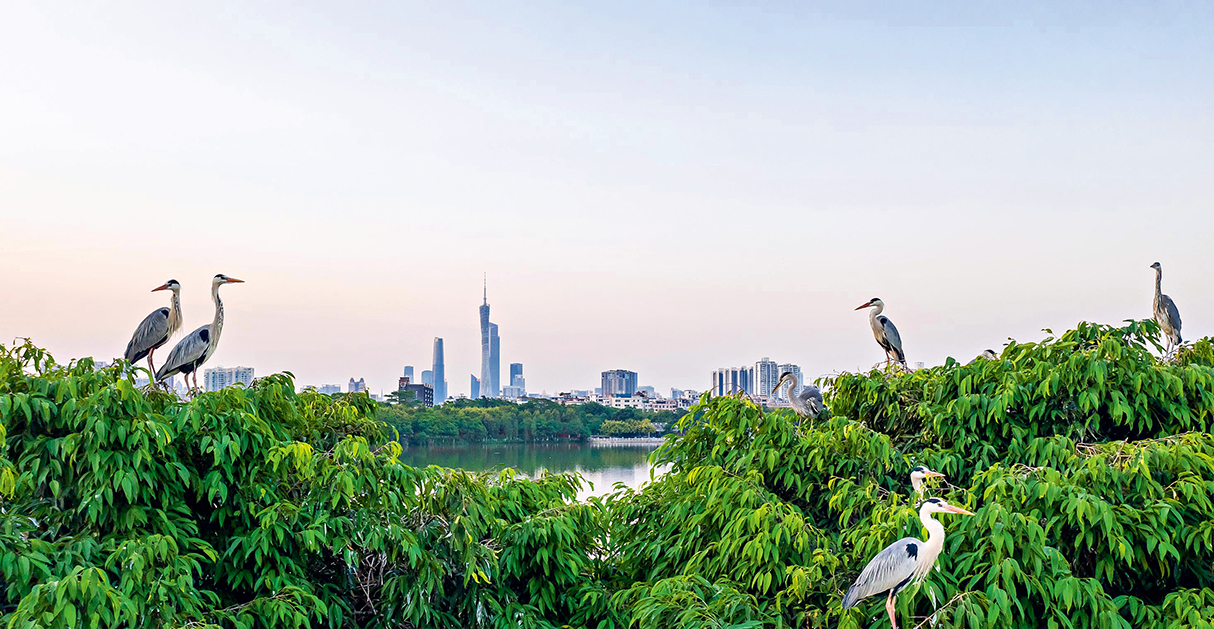
Grey herons perch in Haizhu National Wetland Park in Guangzhou, south China’s Guangdong Province, on April 27, 2020. (XIE HUIQIANG)
2020 was supposed to be a big year for nature, with several global climate conferences such as the UN Ocean Conference, IUCN World Conservation Congress 2020, UN Convention on Biological Diversity COP 15, and the meeting of Water and Climate Change set to chart a course for slowing climate breakdown and protecting biodiversity over the next decade. Even though most of these conferences have been postponed due to the outbreak of COVID-19, the biodiversity crisis never observed a shutdown.
“We must embrace, acknowledge, integrate, and act for nature in everything we do,” said Inger Andersen, executive director of the United Nations Environment Program. “We are losing species at a rate 1,000 times greater than at any other time in recorded human history and 1 million species face extinction. We are facing a major opportunity to bring nature back from the brink.”
Biodiversity Crisis
Biodiversity describes the whole range of living things and systems on this planet. It is usually explored at three levels: genetic diversity, species diversity, and ecosystem diversity. These three levels work together to create the complexity of life on Earth.
“Without biodiversity, there is no future for humanity,” said Professor David Macdonald at Oxford University. “Biodiversity sustains human livelihood. The air we breathe, the water we drink, the food we eat, and the energy we use all ultimately rely on biodiversity.”
One study estimates that each year, the goods and services created by the planet’s ecosystems contribute trillions of dollars to the global economy, more than double the world’s gross domestic product (GDP). From an aesthetic point of view, every one of the millions of species is unique—a natural work of art that cannot be recreated once lost.
Biodiversity is fundamental to both planet and people but now it is in crisis. According to the Global Assessment Report on Biodiversity and Ecosystem Services published by the Intergovernmental Science-Policy Platform on Biodiversity and Ecosystem Services (IPBES) in 2019, around 1 million animal and plant species are now threatened with extinction, many within decades, more than ever before in human history.
The average abundance of native species in most major land-based habitats has fallen by at least 20 percent, mostly since 1900. More than 40 percent of amphibian species, almost 33 percent of reef-forming corals, and more than a third of all marine mammals are threatened. The situation is less obvious for insect species, but available evidence supports a tentative estimate that 10 percent are threatened. At least 680 vertebrate species had been driven to extinction since the 16th Century, and more than 9 percent of all domesticated breeds of mammals used for food and agriculture had become extinct by 2016, with at least 1,000 more breeds still threatened. In Asia, many species like the Sumatran orangutan, South China tiger, and Sunda pangolin may soon disappear forever.
“Scientists have identified five mass extinctions in Earth’s history, but the crucial difference is that this time the threat is humans,” said Sandra Diaz, co-chair of the report of IPBES. It defines five main categories of direct drivers to the loss. In descending order, they are changes in land and sea use, direct exploitation of organisms, climate change, pollution, and invasive alien species.
The report noted that since 1980, greenhouse gas emissions have doubled, raising the average global temperatures by at least 0.7 degrees Celsius, and that climate change is already impacting nature from ecosystems to genetics—impact expected only to grow over coming decades, in some cases surpassing the impact of land and sea use change and other drivers.
Despite some progress on conserving nature through policy, global goals on conserving and sustainably using nature and achieving sustainability cannot be met by current trajectories. Good progress has been made on only four components of the 20 Aichi Biodiversity Targets (the Aichi Biodiversity Targets for the 2011-2020 period was adopted at the 10th meeting of the Conference of the Parties of the Convention on Biological Diversity held in Nagoya, Aichi Prefecture, Japan, in 2010), so it looks increasingly likely that most will be missed by the 2020 deadline. Current negative trends in biodiversity and ecosystems undermine progress towards 80 percent of assessed targets of Sustainable Development Goals related to poverty, hunger, health, water, cities, climate, oceans, and land. Loss of biodiversity becomes more than an environmental issue and affects development, economics, security, social systems, and morale.
“Governments need to integrate biodiversity considerations across all sectors—not just better environmental policies but better policies on agriculture, infrastructure, and trade,” said Sandra Diaz. “It’s all about putting nature and the public good first rather than the narrow economic interests of a minority. It’s as simple—and as difficult—as that.”
Halting Biodiversity Loss
To conserve global biodiversity, the Global Seed Vault has been one successful practice. Deep inside an icy mountain on a remote island in the Svalbard archipelago, halfway between mainland Norway and the North Pole lies the Global Seed Vault. The purpose of the facility is to store seed samples from all the world’s crop collections. Millions of seeds from more than 930,000 varieties of food crops are stored in the vault. It is a safety deposit box holding the world’s largest collection of agricultural biodiversity.
The facility, which was fully funded by the Norwegian government in 2008, offers any government access to seeds in case of natural or man-made disaster. The concept was successfully tested in 2015 with a seed withdrawal to help Syria re-establish crops wiped out by the country’s civil war.
According to the UN Food and Agriculture Organization, more than 1,700 gene banks are housing food crops around the world. The U.S. has more than two dozen repository centers affiliated with the U.S. National Plant Germplasm System which works to preserve genetic diversity of plants through state, federal, and private organizations.
As one of 17 mega-biodiversity countries which account for at least two thirds of all non-fish vertebrate species and three quarters of all higher plant species in the world, China harbors nearly 10 percent of all plant species and 14 percent of animals on Earth according to the United Nations Development Programme (UNDP). The Chinese government considers conservation of biodiversity tremendously important.
China has established more than 11,800 protected areas covering 18 percent of its land area and 4.6 percent of its sea area as part of a drive to build the world’s most expansive mechanism for management of protected areas by 2025, according to an October 2019 announcement from China’s National Forestry and Grassland Administration.
China’s nature reserves, including 35 million hectares of natural forests and 20 million hectares of wetlands, now safeguard 85 percent of the country’s total wildlife and 65 percent of its vascular plants.
From 2016 to 2020, a total of 349 million yuan (US$51 million) was invested to launch major biodiversity conservation projects and organize surveys and assessments of species and genetic resources in important regions. This spending is ensuring China gains adequate understanding of the background of the species, their distribution, threat factors, and protection status.
China has consistently remained active in international cooperation. China has made significant progress on reaching the Aichi Biodiversity Targets, three of which have been achieved ahead of schedule. The COP 15 on Biological Diversity is set to be held in Kunming, southwest China’s Yunnan Province. Many global entities and stakeholders will visit China to promote global biodiversity conservation and formulate a blueprint for the next 10 years.
“The state of biodiversity is not where we would like to have it,” said Inger Andersen. “We can do more as a global community. We are looking forward to the next Conference of Parties to the Convention on Biological Diversity (CBD) in Kunming and hope the world will come together to agree on stronger commitments to protect species.” Andersen has been encouraged by China’s program to restore degraded ecosystems and expressed confidence that Beijing’s ecological civilization model could become a template to guide the global biodiversity conservation agenda.
Both China and ASEAN are rich in biodiversity, and the two have made biodiversity conservation a priority area of cooperation since 2009. To deepen pragmatic cooperation, China and ASEAN countries have organized seminars on topics of ecosystem improvement, conservation of mangroves and peatland, and conducted joint research and capacity building activities. The latest issue of China-ASEAN Strategy on Environmental Protection Cooperation and Action Plan (2021-2025) will strengthen cooperation on biodiversity conservation and ecosystem management, according to the Ministry of Ecology and Environment of China.
In 2006, support from the Asian Development Bank (ADB) helped several Greater Mekong Subregion (GMS) members including Cambodia, Laos, Myanmar, China, Thailand, and Vietnam launch joint efforts to reduce ecosystem fragmentation in major trans-boundary biodiversity landscapes in the subregion. The Biodiversity Conservation Corridors Initiative is a flagship component of the program. It is an innovative approach combining poverty reduction with biodiversity conservation.
The evaluation report published by ADB in 2019 found that the program in GMS generated transformative effects by engaging different sectors and developing regional collaborative mechanisms to prioritize environmental concerns. Thanks to the program, improving the capacity of environmental managers has emerged as a higher priority in the region. Still, plenty of work remains to be done to create an environmentally friendly and climate-resilient region for all GMS members.
L0013.T001.JPG
China has established more than 11,800 protected areas covering 18 percent of its land area and 4.6 percent of its sea area as part of a drive to build the world’s most expansive mechanism for management of protected areas by 2025.
L0013.T002.JPG
China’s nature reserves, including 35 million hectares of natural forests and 20 million hectares of wetlands, now safeguard 85 percent of the country’s total wildlife and 65 percent of its vascular plants.
Key Statistics
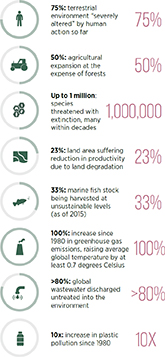
SUSTAINING TOMORROW
Disruption of the ecological balance could upend everything
“Some evil spell had settled on the community: mysterious maladies swept the flocks of chickens; the cattle and sheep sickened and died. Everywhere was a shadow of death.”
So biologist Rachel Carson described a fictional American town in her acclaimed 1962 book Silent Spring, which opened with a “fable for tomorrow.” The maladies were caused by indiscriminate application of DDT and other chemical pesticides which were already exerting massive damage on wildlife, livestock, pets, and even humans. It seems unthinkable we would blanket the Earth with such poisons, but we have.
Nature-based solutions to climate, food and water security, and sustainable livelihood all depend on biodiversity—the foundation for a sustainable future. However, socially among humans, full development of production has wide consensus as a must to feed the surging population and maintain economic benefits. Indiscriminate usage of DDT and other pesticides (or biocides) is not the only foreshadow of death. Cold reality is that due to rapid development of industrialization, biodiversity is vanishing at an astonishing rate unseen in human history, all on our watch.
Conquest or Coexistence
The soil on this planet nurtures all kinds of organisms along the ecological food chain. In Carson’s view, all living things on Earth are closely related, all species are interdependent, and all creatures are dependent on Mother Nature. All animals and plants on Earth, upon which man depends, compose this magical and beautiful biosphere. Any disruption of the balance of the sphere could cause disaster to the entire ecosystem.
“Man conquering nature” used to be an expression of a heroic spirit to in some way tame the wilds. While promoting the development of science and technology alongside the advancement of human civilization, humans have often transformed nature according to subjective wishes to get more from it. Reckless interference, abuse, and destruction of nature has left us in an almost insurmountable ecological crisis.
The environmental Kuznets curve (EKC) shows that environmental protection rises as a priority alongside economic prosperity. It is conventional wisdom that the environment pays the inevitable price for development. Forest fires across Indonesia have been a problem for years, especially in 1991, 1994, and 1997. Some reports blamed on El Niño for fires, but others estimated that 80 percent of Indonesia’s forest fires in 1997 were caused by big-operation farmers seeking to exploit wilderness.
The EKC is not absolute, however. Lu Zhi, a professor of conservation biology at Peking University and executive director of the university’s Center for Nature and Society, noted that in China’s areas inhabited by ethnic minorities, many people endure difficult lives yet still maintain strong awareness for ecological protection and actively participate in it. In February 2019, an avalanche dropped in Yushu Tibetan Autonomous Prefecture of Qinghai Province. Many local herders spontaneously carried foliage into the mountains to save wildlife. Such behavior is not about monetary incentives or legal obligations, but a response to values. Such efforts are quite inspirational for environmental protection.
Environmental degradation is inseparable from human well-being. Kathy Willis, professor of global biodiversity at Oxford University, has a unique view of the “value” of man and nature. She thinks that people don’t like to put a label of “value” on biodiversity but are forced to. Without trees in the streets, incidence of asthma would increase dramatically. If the positive impact of nature is lost, people would need to rely on more costly but less efficient technological solutions to replace the benefits. Such technology seems like a tall order.
In September 2020, the Summit on Biodiversity will convene on the margins of the 75th session of the UN General Assembly. Xie Yan, associate research fellow at the Institute of Zoology under the Chinese Academy of Sciences, thinks that most countries globally are unaware of the significance of biodiversity on the long-term survival of their own people. Heads of state and government in attendance of the summit need to be fully aware that biodiversity conservation is, first and foremost, the duty of a state. Each nation must protect the ecological security of its own people.
Biodiversity & Public Health
In 2020, we experienced some deaths quite different from Carson’s “silent spring.” The outbreak of COVID-19 pressed the “pause” button on cities. Streets that were perpetually bustling with traffic and pedestrians went silent in the blink of an eye. Noisy factories went silent. Everybody was hidden behind a mask and stayed away from others. The coronavirus still spreads across the world, resulting in millions of infections and hundreds of thousands of deaths, not to mention an unprecedented impact on global economics, trade, diplomacy, and social psychology.
Although the source and route of transmission of the virus have not been scientifically confirmed, most studies so far trace the virus to nature. Scientists generally agree that it jumped from natural hosts of wild animals such as bats and pangolin to humans via intermediate hosts.
In recent years, new infectious diseases have constantly emerged around the world such as Hendra virus (HeV), Nipah virus (NV), H7N9 avian influenza, Ebola, SARS, MERS, and many more—all associated with animals. Frequent contact between humans, wildlife, and livestock always risks exposure to infectious diseases that could threaten the health of all. The growth of international trade, including trade of wildlife both legal and illegal, with increasingly convenient transnational transportation of people, has made it easier for infectious diseases to spread regionally and even globally.
Lu Zhi believes that these viruses have existed in nature and evolved in tandem with their hosts for a long time, striking a delicate balance. However, illegal trade and consumption of wildlife, or encroachment into wildlife habitats, can lead to a significantly greater exposure to these viruses among humans and endanger public health security. The trend of globalization, convenience of transportation, and faster movement of people have all increased the risk of infectious disease outbreaks.
The connection between biodiversity and public health security has never been as painfully close as today. Under the leadership of President Xi Jinping, China is making major contributions as a big country rich in biodiversity resources. Elizabeth Maruma Mrema, executive secretary of the UN Convention on Biological Diversity, applauded China’s development philosophy of “ecological progress.” She praised China’s strong determination to prioritize biodiversity through rigorous protective measures such as setting red lines for ecological conservation.
To preserve biodiversity, China enacted the Law of the People’s Republic of China on the Protection of Wildlife back in 1989. A quarter of a century later, the Standing Committee of the National People’s Congress amended the law to fully ban illegal hunting, trading, transportation, and consumption of wild animals.
Human activity makes a huge impact on the ecosystem. Dr. Li Binbin, assistant professor of environmental sciences at the Environmental Research Center at Duke Kunshan University in east China’s Jiangsu Province, attributed great changes in the ecosystem to human activities such as new land usage, intensive agricultural production, and introduction of antimicrobial agents, which all exacerbate the risk and potential impact of infectious disease outbreaks. Change in land usage is the most important factor contributing to the increase in infectious diseases caused by wildlife. A study in the Amazon Basin found that incidence of malaria increased by 50 percent when forest cover decreased by 4 percent due to human activities such as logging because the hydrothermal conditions in the deforested areas became more conducive to breeding of intermediary host—mosquitoes. In the biosphere, human interference does not often directly change species diversity but increases the probability of transmission of pathogens by affecting species composition and community vulnerabilities.
“This is not simply an ecological environment problem,” commented Wang Huo, deputy secretary-general of the China Biodiversity Conservation and Green Development Foundation. “The dramatic loss of biodiversity is an unprecedented and enormous challenge for humanity. The most important step is to fully mobilize all the people from all walks of life to participate in the protection of biodiversity.”
At the end of her book, Carson wrote: “The people had done it themselves.” She claimed that all kinds of people had some role—rich and poor, men and women, even newborn infants. Today, 60 years later, Carson’s once controversial views are gaining support. Awareness of biodiversity conservation is rising, and people are contributing to it with concrete action. The little improvements are like bird songs in a silent spring—as sign of hope and expectations.
“We are the last generation with a chance to save biodiversity,” added Wang. “It’s not too late to make some changes.”

The offspring of giant panda “Cao Cao” is transferred by keepers in panda costumes to a new location in a tailor-made basket for the second phase of field training in Wolong Nature Reserve, Sichuan Province, on February 20, 2011. (HENG YI)
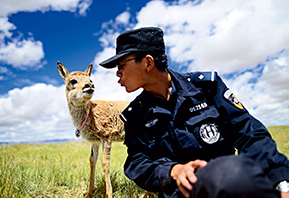
Assistant police officer Xie Ancheng shares a delightful moment with a baby Tibetan antelope in Hoh Xil, a haven for wildlife and ecological protection in Yushu Tibetan Autonomous Prefecture, Qinghai Province, on August 15, 2017.(ZHANG HONGXIANG)

Hu Shibin, head of a patrol team monitoring the Yangtze River in Anqing, Anhui Province, displays a picture of a dead Yangtze cowfish (Finless porpoise) found on August 9, 2017. Since the end of June 2017, Hu’s team had patrolled the river several times a week. (LIU JUNXI)
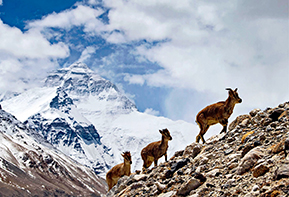
Blue sheep in the Qomolangma National Nature Reserve in Tibet Autonomous Region, on April 29, 2020. (PBUZAZI)
L0017.T001.JPG
A study in the Amazon Basin found that incidence of malaria increased by 50 percent when forest cover decreased by 4 percent due to human activities such as logging because the hydrothermal conditions in the deforested areas became more conducive to breeding of intermediary host—mosquitoes.
BIODIVERSITY CRISIS
By Yuan Yanan
According to the United Nations (UN), nature is declining globally at rates unprecedented in human history, and the rate of species extinction is accelerating. About 1 million animal and plant species are now threatened with extinction. Experts say that with current trends, by 2100, an estimated 50 percent of all the world’s specieswill go extinct.
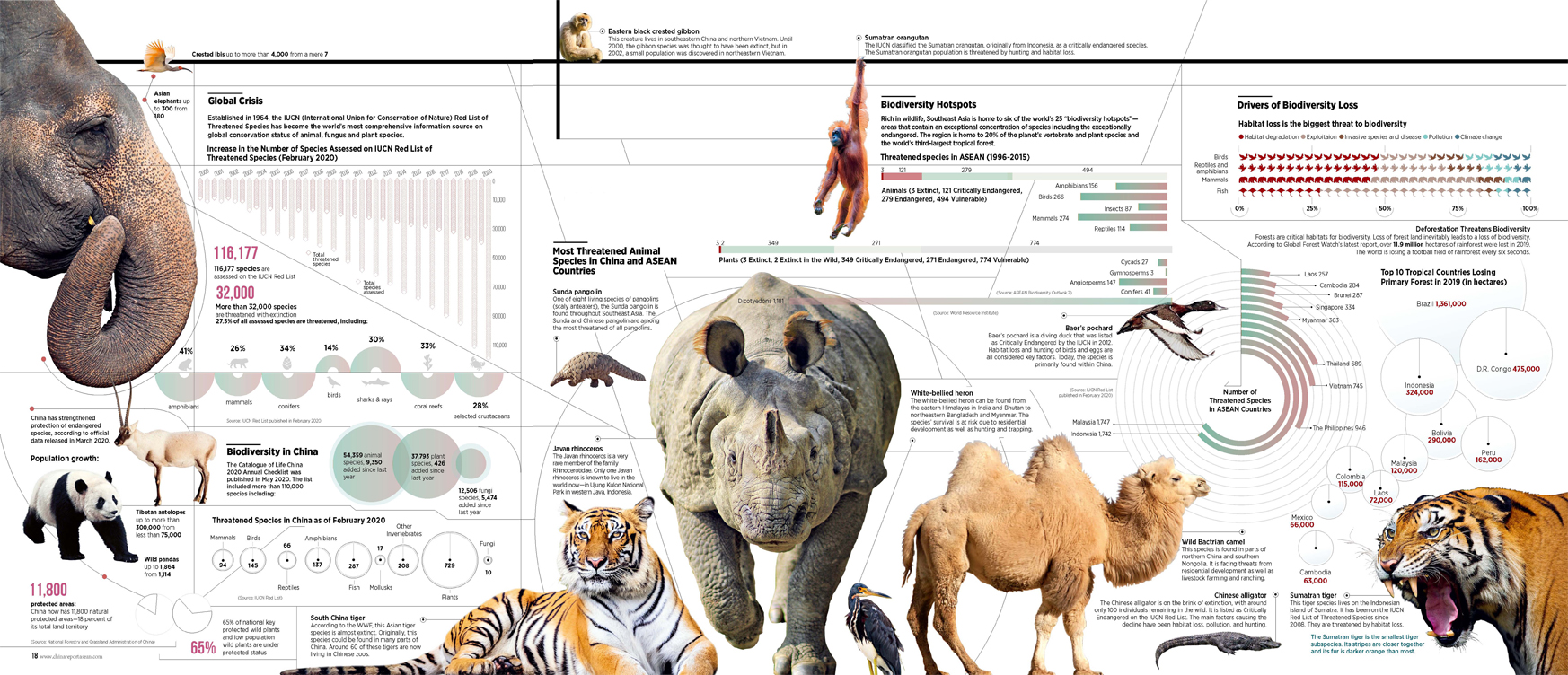
ETERNAL EXTINCTION
By Yuan Yanan
Nature is declining globally at rates unprecedented in human history, and the rate of species extinctions is accelerating. Human activity is the greatest driver of this phenomenon. There is no return from extinction, and loss of a species is an eternal disappearance of one tile in the mosaic of life. It’s a loss for all life on Earth.
A species is declared extinct with certainty only after decades without a sighting. Here are some species we’ll never see again.

SMALLER CITY DWELLERS
Can we find a way to coexist harmoniously with wildlife in cities?
By Yuan Yanan
On the evening of July 7, Shanghai resident Chen Yuanyuan was out on an after-dinner walk on a cobble-stone path in her residential area, wearing pants and slippers, when a racoon dog (Nyctereutes procyonoides) the size of a cat darted through the high grass. The animal scratched the back of her heel before leaning its tiny head on her ankle. “I felt it clinging to my ankle when it suddenly jumped back into the high grass on the other side of the path,” said Chen.
The incident resulted in a large gash on Chen’s foot. In the hospital emergency room, she was vaccinated for rabies. Since then, the formerly fearless woman has refrained from going out at night. When she takes a walk in her neighborhood, she dresses more carefully and wears proper shoes.
News of Chen’s encounter with a racoon dog jolted the nerves of the whole neighborhood. The neighborhood committee received more complaints about the racoon dogs as well as requests to have them moved or caged.
The incident drew the attention of Wang Fang, a researcher at the School of Life Sciences of Fudan University, who specializes in wildlife population, community ecology, and conservation biology. In recent years, he led a team of volunteers to survey the racoon dog population in Shanghai.
The racoon dog is a canid indigenous to Shanghai which has been fortunate enough to enjoy a population increase in recent years, with its habitat expanding from the city’s west end to the east. Wang Fang sees this as a sign of the city’s ecological restoration. The racoon dog is born timid and doesn’t dare get close to humans, especially before a year of age. Therefore, under normal circumstances, they are unlikely to attack people. After on-site surveys, Wang determined that the woman had encroached on its territory, which indicates an imbalance in the relationship.
“Feeding wild animals is against the laws of nature,” said Wang. “When people feed wild pups, they stop being afraid and keeping a distance.” His survey team witnessed a fierce melee in a residential area over cat food involving dozens of adult racoon dogs as their young ones looked on eagerly.
“New-born racoon dogs should look for new habitats and learn new skills. But human feeding has changed their survival habits and dramatically increased their population. When they fail to get enough from man, they will vent their anger against us,” Wang added.
Such incidents have awoken many to the breadth of the wildlife sharing urban spaces with people. We should figure out how to coexist harmoniously with wildlife in cities.
Adaptation
The rapid process of urbanization has brought about dramatic changes in wildlife habitats. In this process, some wild animals were forced to migrate to habitats more suitable for survival, while others that could not adapt to a new environment vanished forever. In contrast, some viable species have begun to shift habitats to exploit the plentiful resources cities have to offer.
Wang Fang believes that some wild animals have adapted to urban life far faster than we can imagine. For example, the North American raccoon (Procyon lotor) has learned to identify traffic and different types of urban buildings over the last 20 to 30 years. Yellow weasels are generally known as nocturnal animals, but without human interference, they hunt during the day fairly frequently. In urban areas, their day-time activity drops significantly compared to the night. Under natural conditions, if a person approaches nests or habitats of badgers or racoon dogs, they growl ferociously and attack quickly. In urban environments, however, they tend to be more tolerant.
From a biological evolution perspective, urbanization is having a profound impact on species. In 2008, a French scientist hypothesized that urbanization has already affected the evolution of species. He noticed that Tibetan hawksbeard roots (a herbal plant) grown in the city produce larger seeds than the same species grown in the countryside. He thought that the heavier seeds would be less likely to be blown by the wind onto far-off concrete roads, with a tendency to drop in nearby soil which would lead to a higher survival rate.
Dutch urban ecologist Menno Schilthuizen also looked at the impact of large-scale urbanization on wildlife evolution. He calls cities “pressure cookers” on biological evolution. He argues evolution which used to take hundreds of years or more has been dramatically accelerated in cities.
In his book Darwin Comes to Town, Schilthuizen quoted some examples of species that have thrived and evolved in cities. For example, the mice living in different districts of New York City exhibit different DNA profiles. The urban heat-island effect causes the temperature in cities to measure higher than in surrounding areas. Snails living in urban areas become lighter in color to absorb less heat. Pigeons living in cities look darker because the melanin in their feathers insulates them from toxic metals. Scavenger crows in Sendai, Japan, learned to crack nuts with passing vehicles. Lizards in Puerto Rico have evolved claws more suitable for latching onto concrete. Moths in Europe have become less attracted to deadly artificial light. He cited these as evidence that urban environments are accelerating evolution of species in amazing ways.
Living with Animals
While wild animals seek to integrate into cities, humans are beginning to recognize the importance of environmental protection and inclusiveness of urban biodiversity. With the improvement of urban environments, more wild animals are returning to human life.
In the 1970s, water pollution in Singapore caused the otters in its rivers to disappear. In 1977, the Singaporean government launched the Clean River Campaign to improve water quality. In 1998, the aquatic mammal showed up again after a long absence. Today, about 90 otters share the urban space in Singapore. Despite a 2017 incident in which an otter bit someone, the locals have overwhelmingly enjoyed their company. In 2016, the mammal was voted the national mascot for the country’s National Day celebration. The Singaporean government has also placed icons and signs in the hot spots of otter activity to protect them and manage potential conflict with man.
“The formation of cities is the result of humans being attracted by the soil and water of certain locations, which is also attractive to wildlife,” commented Wang Fang. “Human beings didn’t congregate at these locations before wild animals.” Humans demand material and spiritual nourishment from urban biodiversity but doing so requires managing emerging problems effectively. “For example, the improvement of urban environments can cause the squirrel population to grow and start stealing our cat and dog food or chewing up our stuff. Similar afflictions have persisted in countries with great ecosystems,” Wang said.
In Berlin, Germany, the rivers, lakes, and green spaces in the urban area have attracted more than 3,000 wild boars. The animals’ settlement in the urban area has been troublesome for the surrounding parks and communities. In Bristol, England, more than 20 red foxes can be found per square kilometer in the urban area, which poses a threat to many rare terrestrial mammals and small birds.
China has faced similar problems in recent years. In Shenzhen, leopard cats were spotted in the residential area of Overseas Chinese Town. Wild boars found their ways to the city centers of Nanjing and Hangzhou, posing new challenges for urban governance. Experience has shown that measures such as poisoning or selective slaughter do not control the development of such species. Such intervention, on the contrary, can lead to ecological chain disasters.
Conservation of biodiversity in cities is more complex than in the wild. Wang Fang believes that in cities, man needs to be more proactive in biodiversity design and scientific management. In urban landscape design, biological management needs careful consideration. “For example, we need to consider how green space should be built, how canals should be built, and how the basic biodiversity of a city should be maintained through practical measures,” said Wang. “For some harmful species, you have to intervene. For example, everyone supports controlling rat infestations. In the farmland where pests and locusts are raging, control measures are a no-brainer.”
Much remains to be done on this front. The public is being discouraged from feeding wild animals. The government is expected to organize volunteers and researchers to monitor and research wildlife to gather more detailed information.
Environmentally Sustainable Cities
According to 2018 UN statistics, more than half of the world’s population lives in cities, and the proportion is expected to rise to 66 percent by 2050. Cities have become an important part of natural ecology. However, urban biodiversity is facing many challenges: climate and local environmental changes, invasive alien species, and urban expansion into natural spaces which is resulting in habitat destruction and fragmentation that could threaten the survival of man and other species. A path to healthy urban-wild development is a must.
In the ASEAN region, coastal cities are economically vibrant, but excessive resource development and growing pollution are threatening the development of biodiversity. The ASEAN Biodiversity Outlook noted that if urban development is left unchecked and environmental considerations are not prioritized against economic and industrial progress, cities might eventually become unlivable. The report described how over-exploitation of biological resources and invasive alien species as well as other forms of biodiversity neglect pose a major threat to the healthy development of ASEAN cities. ASEAN has called on all member states to take active measures to enhance the public awareness on biodiversity conservation and integrate biodiversity into urban development planning. ASEAN also proposed building Environmentally Sustainable Cities and established the Environmentally Sustainable City Award to highlight role models for sustainable development of cities.
In October 2010, the Singapore Index on Cities’ Biodiversity (Singapore Index) was formally adopted by the international community. The index includes three categories of indicators: native biodiversity, ecosystem services provided by biodiversity, and governance and management of biodiversity. The Singapore Index has been instrumental in helping local, national, and regional government departments share information on measuring biodiversity. The index enables city managers to evaluate and monitor the progress of their biodiversity conservation efforts against their own individual baselines and adjust strategies accordingly.
China and ASEAN have accelerated cooperation on building eco-cities. In 2015, China-ASEAN Partnership for Eco-friendly Urban Development was established to boost cooperation in green and sustainable urban development. Today, more than 20 cities from across the region are involved in cooperation in urban planning, water management, and other areas.
Cities are the common habitats of man and wildlife. Much remains to be learned about how they can coexist harmoniously in an eco-friendly urban environment.
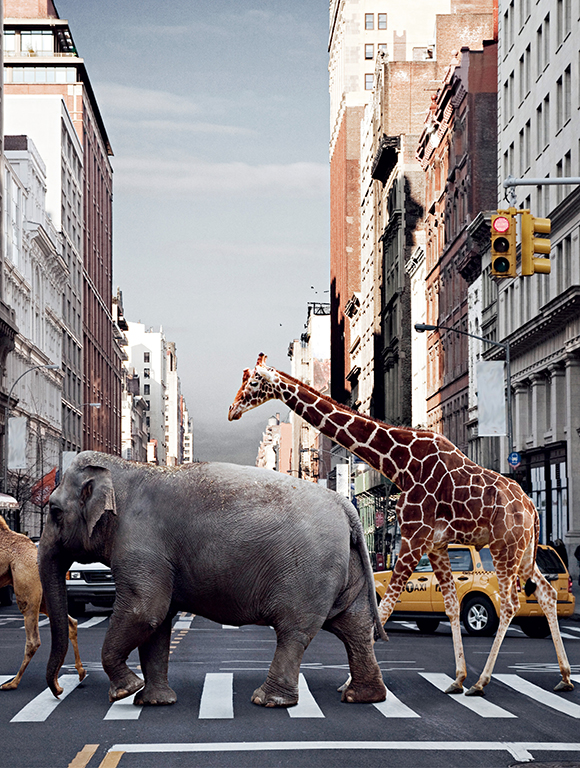
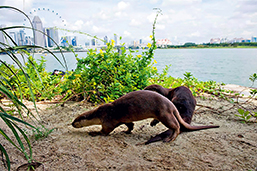
Two otters in Singapore’s Gardens by the Bay, 2015. (DENG ZHIWEI)

A long-tailed macaque looks for food in Singapore’s MacRitchie Reservoir Park on July 7, 2015. (DENG ZHIWEI)

A team of resident volunteers conducts an animal survey in Shanghai. (WANG FANG)

Racoon dogs residing in the basement of a residential building in Qingpu District, Shanghai. (WANG FANG)
NO LONGER A CIRCUS ACT
Elephant-friendly tourism is providing better wildlife welfare
By Guo Meng
Elephants remain big business for many tourism venues offering interactions such as riding, dancing, painting, swimming, or photo ops. How do the elephants feel about these activities? Global consensus is that it’s mostly horrific abuse. The animals don’t know what it’s all about or why they get punished for failure. The gentle giants have tender hearts. They look muscular under the rough skin, but they are still sensitive to pain. Those used to entertain tourists with tricks at money-spinning shows are removed from their families and tamed by mahouts (elephant handlers) with abusive methods such as pointed hooks. After the shows, they are chained up and live miserably.
“For many tourists, traveling to Asia wouldn’t be complete without an encounter with an elephant, be it seeing a show, riding, or bathing one,” said Audrey Mealia, Global Head of Wildlife at World Animal Protection (WAP), an international animal welfare organization. “Yet sadly, elephant-loving tourists who want that ‘once in a lifetime’ opportunity are fueling demand for a mammoth sized problem that causes unthinkable cruelty behind the scenes, even if they don’t realize.”
The coronavirus has decimated the number of foreign tourists to Thailand, resulting in “layoffs” of more than 1,000 elephants used in the country’s tourism sector. Save the Elephant Foundation, a non-profit organization based in Chiang Mai Province of northern Thailand, has been seizing the pandemic as opportunity to save elephants. They became known for publicizing elephant abuse in tourist shows. Their mission is to save elephants from tourism and send them back to their native lands.
Elephant-Friendly Tourism
Despite the pandemic, Hug Chang Chiang Mai Elephant Camp in Thailand remains open to tourists. The camp is an eco-friendly tourism attraction that allows tourists to observe elephants. The manager on-site reported an average of 20 to 30 tourists to see the elephants every day before the coronavirus outbreak, but few to none since. The camp is a sanctuary for 12 elephants which receive good care from mahouts with regular checkups and walks in the woods. With proper treatment, elephants are very friendly with tourists.
Jirada Moran, a 5-year-old Thai TV star, visited the camp a few days ago. She prepared food for the elephants and watched them frolic in the woods and lakes.
“Elephants are our friends,” said Moran. “I’m happy to interact with them like this and express love for them.”
On June 30, 2020, the WAP released its first research report on excellent practices in wildlife-friendly tourism. The report showed that global wildlife tourism, which is growing at a rate of 10 percent every year, is expected to reach 12 million trips annually in coming years. The report also suggested wildlife-friendly tourist attractions include several core elements: no interference with the natural behavior of the animals, management and education of tourists, solid customer reviews, and earnest efforts to promote local wildlife protection.
With support and assistance from WAP, Chiang Mai ChangChill Elephant Camp has transformed from a tourist entertainment attraction to an elephant-friendly high-welfare venue. In Thai, ChangChill means “resting elephant,” which was chosen with hope that the elephants find a new life there. From observation platforms, tourists can acquire detailed information on the background of each elephant. Tour guides caution tourists to avoid flashlights, carrying food, staying alone, making loud noises, and getting too close to the elephants.
Over the past decade, the WAP has followed up on the welfare of captive elephants in tourism in Southeast Asia with three comprehensive empirical studies. The latest study evaluated the welfare condition of 3,837 elephants at 357 venues in Thailand, India, Laos, Cambodia, Nepal, Sri Lanka, and Malaysia. The study found that 63 percent of captive elephants were suffering in severely inadequate conditions, 30 percent were in improved, yet still inadequate conditions, and only 7 percent were kept in high-welfare venues.
“Elephant-friendly tourism” is an initiative from the WAP to push tourism operators to stop selling and promoting travel products such as elephant riding and show, and to promote the transformation of the tourism industry to “animal-friendly” sustainable development. So far, more than 250 tourism operators from around the world have pledged to remove wildlife entertainment products such as elephant riding and performing.
Positive Changes
August 12 is World Elephant Day. Recently, the Thai Elephant Alliance Association organized a seminar for owners of private elephant camps in Chiang Mai to exchange views on the negative impact of the pandemic on camps and ways to help camp owners and elephant owners improve the welfare conditions of elephants.
“Ongoing suffering – but also some positive changes,” declared a WAP report titled Elephants. Not commodities–Taken for a ride 2, which evaluated the welfare conditions of 3,837 elephants at 357 venues in Asian countries from January 2019 to January 2020. The report concluded that 2,390 (63 percent) of the elephants were suffering in severely inadequate conditions at 208 (58 percent) venues, 1,168 (30 percent) were experiencing improved, yet still inadequate conditions, and only 279 (7 percent) were kept at high-welfare observation-only venues.
Distressing conditions at venues with severely inadequate welfare conditions include: frequent restrictions with short chains, demanding activity schedules, limited freedom for social interaction, and conditions that allowed for very little natural behavior. Venues with improved yet still inadequate conditions often offered half or full-day elephant swimming or bathing experiences. Despite tourist perceptions that elephant washing and bathing venues treat elephants well, concerns about these attractions are well documented because such close contact requires harsh training conditions. The attractions also prevent the elephants from ever returning to the wild.
The coronavirus outbreak has underscored the vulnerability of captive elephants and their dependence on tourism. Tourism venues have been struggling to feed the animals as of late. In Thailand alone, it is estimated to cost more than US$900,000 a month to feed all the elephants and a similar figure to pay mahouts. The WAP and other international and local non-governmental organizations have offered help to save the animals from hunger.
Zhao Zhonghua, chief representative of the WAP’s Beijing office, explained that wildlife-friendly tourism not only protects wildlife, but also better conforms to policy and market changes because operators’ risk drops drastically when they live more sustainably. It has emerged as an important way to protect natural heritage and biodiversity.
Elephants are marquee victims of wildlife mistreatment in the tourism sector. “Elephant-friendly tourism” is expected to soon become the new normal as the last generation of captive animals are returned to their native land.
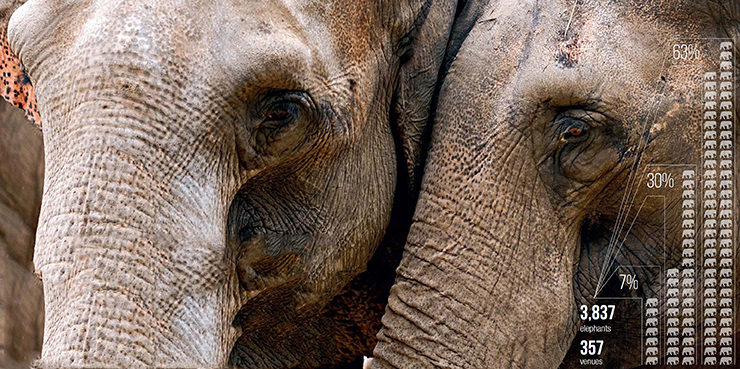
The latest study evaluated the welfare condition of 3,837 elephants at 357 venues in Thailand, India, Laos, Cambodia, Nepal, Sri Lanka, and Malaysia. The study found that 63 percent of captive elephants were suffering in severely inadequate conditions, 30 percent were in improved, yet still inadequate conditions, and only 7 percent were kept in high-welfare venues.
DEMYSTIFYING BIODIVERSITY
Interview with the Executive Director of the CAS Southeast Asia Biodiversity Research Institute
By Wang Fengjuan
Booming economic development and a steeply increasing population have led the Southeast Asian subregion into multiple ecological environmental issues that demand analysis and resolution by China and ASEAN countries in tandem as regional players continue expanding international exchange and cooperation on biodiversity. China Report ASEAN interviewed Quan Ruichang, executive director of Southeast Asia Biodiversity Research Institute of the Chinese Academy of Sciences (CAS-SEABRI) and a researcher at Xishuangbanna Tropical Botanical Garden of the CAS, who elaborated on biodiversity cooperation between China and Southeast Asia.
China Report ASEAN: What is the current situation of biodiversity in Southeast Asia?
Quan Ruichang: Southeast Asia is one of the world’s three core tropical rainforest distribution areas and has some of the most abundant biodiversity and unique species in the world. It is also a key region for researching the origin, maintenance, and evolution of biodiversity. The adverse impacts of the booming population, rapid economic and social development, over-exploitation of natural resources, global climate change, exotic species invasion and hunting and illegal trade have caused the biodiversity resources in the region to fall under serious threat. A wide range of species have gone extinct rapidly, so protection of biodiversity has become an urgent and difficult task.
China Report ASEAN: CAS-SEABRI is a scientific and educational institution established overseas by CAS and committed to conducting cooperation on biodiversity research, conservation, and sustainability, but what are its main day-to-day functions?
Quan: The CAS-SEABRI mainly focuses on three aspects. First, we organize and implement major scientific research projects and interdisciplinary, trans-regional, and transnational investigations. So far, CAS-SEABRI has carried out nine large-scale joint expeditions in Myanmar, three joint scientific expeditions in northern Laos, and four joint field expeditions to study Cenozoic flora in Vietnam. A research platform for the “forest belt at 101 degrees east longitude” has been preliminarily completed. It consists of 10 large dynamic forest zones including four in China’s Yunnan Province, five in Thailand, and one in Malaysia which together form a forest belt spanning the core area of tropical Asia and stretching to the hinterlands of the Qinghai-Tibet Plateau/Hengduan Mountains.
Second, we carry out strategic research and policy consulting on biodiversity conservation and sustainability. In response to declining forest resources in Myanmar, CAS-SEABRI provided technical consulting for the construction of the “China-Myanmar Eco-Friendly Demonstration Forest” in Myanmar, which involved planting 150,000 trees on 100 acres of wasteland. Since 2017, the research team of the CAS-SEABRI has cooperated with universities and research institutions in Myanmar to carry out Chinese hybrid rice experimental planting. The growth period of Chinese hybrid rice grown in Myanmar is 30 to 40 days shorter than in China. Compared with local rice varieties, the Chinese hybrid rice varieties grown at two experimental sites have shown better performance in terms of yield, disease resistance, and lodging resistance, with output up by 23.87 percent and 47.65 percent, respectively.
Third, we provide personnel training, technical training, and science popularization in fields of biodiversity and ecological protection. Since 2016, the CAS-SEABRI has organized training courses such as “Myanmar’s Tropical Plant Identification and Forest Management Training,” “Biodiversity Conservation and Community Development Workshop in Laos,” “Training Course on Breeding and Production Techniques of Major Crops in Southeast Asia,” “Advanced Field Course in Tropical Ecology,” and “China-Laos Trans-Boundary Wild Animals and Plants Joint Protection and Monitoring Technology Training.” The CAS-SEABRI has trained nearly 300 scientific and technological professionals for Southeast Asian countries.
China Report ASEAN: What difficulties and challenges have you encountered while researching biodiversity?
Quan: Intensification of human activities has caused the rate of species extinction to continue accelerating. Many species have gone extinct without ever being named, and many genes have been lost. Different ecosystems are facing fragmentation and sharp reduction in area because of human activities. We urgently need to strengthen the research, protection, maintenance, and rational utilization of biodiversity.
In terms of studying biodiversity in Southeast Asia, the biggest difficulties and challenges are as follows:
First, traditional slash-and-burn methods and large-scale planting of single cash crops such as rubber and oil palm have severely damaged forests in Southeast Asia.
Second, hydroelectric development in the Mekong River Basin poses a threat to the habitat of animals and plants, and mining has created a particularly serious threat for karst landforms.
Third, hunting and trading of wild animals is the greatest threat to the survival of many species. High-value species are still commodities actively sought by criminal groups, while species of lower value are traded for medicinal usage or food.
Fourth, supervision is weak. Due to relatively backward economic development, many governments have not paid much attention to biodiversity, and the corresponding regulatory and organizational structure is lacking.
Fifth, biodiversity transcends borders, and more attention needs to be placed on cross-border protection actions.
China Report ASEAN: Could you share one of your most memorable experiences studying biodiversity?
Quan: While doing research, we need to investigate, collect samples, and make specimens. The conditions for scientific expedition can be relatively difficult. Sometimes, we find bridges destroyed by floods and end up wading through water. In field investigations, it is normal to eat and sleep in the open air. If we are lucky, we can stay with a local family. We must beware of beasts, snakes, insects, and mosquitoes everywhere. You don’t want to get malaria.
One evening in June 2019, on our journey back from a scientific expedition in Htamanthi, Myanmar, a team member found a strange animal on the bank of a river several kilometers from our camp. It was lurking in the darkness, then turned sharply and ran away into the bushes. A colleague rushed to capture a snapshot with a macro lens normally used on plants. After returning to the camp, we guessed that the creature was a crocodile from the blurry photos. According to data, 23 species of crocodiles are on the books worldwide. It would be huge if we could discover a new species of crocodile.
So, we were determined to find it again and organized a “crocodile squad.” The next morning, the squad set off in two small wooden boats, switched their cameras to the telephoto and high-speed continuous shutters, but found nothing after a half day of searching. Everyone still had enthusiasm, so we decided we would look again whenever we had the chance. Searching, discovering, and researching are our daily routines. Difficult conditions do not stop our enthusiasm and love for scientific research.
China Report ASEAN: Since the establishment of the CAS-SEABRI, how many new species have been discovered in Southeast Asia?
Quan: We have completed nine comprehensive field expeditions in many places in Myanmar and discovered 63 new species of animals and plants. Among them, Magnolia kachinensis (Magnoliaceae) and Platea kachinensis are extremely difficult-to-find tree species in recent years. The scientific expedition team found white-bellied herons of which only about 500 are estimated to exist globally, as well as many rare and endangered species such as Bengal tigers, Panthera pardus, and clouded leopards. From 2018 to 2019, three joint field expeditions were carried out in northern Laos, and many animals and plants were photographed and recorded. So far, papers describing four new plant species and seven newly recorded species of plants have been published.
The research team of the CAS-SEABRI has compiled two special journals on new taxonomy of animals and plants and published related research in international science journals such as Zoological Research and Plant Diversity. Two special issues on new classifications of plants and related research were compiled on PhytoKeys, a peer-reviewed, open access, rapidly published journal. Through biodiversity surveys, we can correctly evaluate the status quo and trend of the fragmentation of the ecological environment in Southeast Asia, study patterns of biodiversity, formulate protection measures, and collect better data.

Quan Ruichang, executive director of CAS-SEABRI.

Team members of the China-Myanmar joint field expedition collect plant specimens in a wildlife sanctuary in Myanmar on May 28, 2019. (JIN LIWANG)
WILD DISCOVERIES
Tales of a China-Laos scientific expedition

Forest landscape on the banks of the Mekong River. (SIMON MATZINGER)
The remote areas of northern Laos have been mysterious to the modern world, and scientific expeditions in the wilds of this region are essentially journeys of explorations and discoveries. Laos spans a long horizontal swath of the Indochina Peninsula, which makes it a biodiversity hotspot and an ideal place for scientists to study tropical biodiversity and the evolution and geographical distribution of Southeast Asia’s forests.
China-Lao PDR Transboundary Biodiversity Conservation Collaboration involves scientists from the Xishuangbanna Tropical Botanical Garden (XTBG) of the Chinese Academy of Sciences (CAS) and the Southeast Asia Biodiversity Research Institute (SEABRI) of CAS working jointly on scientific expeditions, of which three have been carried out so far. The scientists dive headfirst into the wealth of life hidden deep in mysterious Laos.
Tropical Diversity in Laos
Laos is the only landlocked country on the Indochina Peninsula. Mountains and plateaus account for around 80 percent of the country’s land, and forest coverage is quite high. However, forest resources are declining rapidly because of extensive planting and forest exploitation, which is undermining the ecology and biodiversity of the country.
Over the last six decades, the XTBG has been engaging in the study of tropical rainforests and the relevant biodiversity along the China-Laos border. In the 1990s, it began conducting technological cooperation with Laos, during which the scientists organized training sessions in rural areas and provided guidance to locals on protecting cross-border biodiversity in northern Laos. In 2005, renowned ethnobotanist Pei Shengji studied the cross-border protective measures taken by China, Laos, and Vietnam, and proposed constructing a cross-border biodiversity reserve where the borders of the three countries converge. He named the reserve the Green Triangle. Then, researcher Chen Jin and his colleagues visited Vietnam and Laos to establish cooperation ties with relevant research institutes in the two counties, laying a foundation for biodiversity protection in the Green Triangle.
In April 2018, researcher Quan Ruichang and Dr. Song Liang from the SEABRI visited the nature reserves in Luang Namtha Province and Phongsaly Province in northern Laos for their first scientific expedition in the wild. They employed various investigative measures such as quadrat sampling, infrared monitoring, and visiting local farmers’ markets to study the birds, animals, fish, and plants as intimately as possible. They also discovered a couple of plant species newly documented in Laos, such as Aeschynanthus longicaulis, and Eleutharrhena macrocarpa, an endangered plant species in China.
In October 2018, Dr. Song took his team back to northern Laos. This time, the scientists gathered more quadrat samples and studied more species of birds, animals, and fish. All the collected information and research findings proved very helpful for learning about the biodiversity in northern Laos.
In April 2019, senior engineer Tan Yunhong led a China-Laos scientific expedition team to conduct field investigations in the Nam Ha National Protected Area in northern Laos. They camped in the field and framed a quadrat of one hectare. In the sample sector, the scientists completed relevant research and labeled all the plants. Alongside studying local animals, plants, and fish, they also investigated edible and medicinal plant resources in the protected area.
Along with the academic value, research of biodiversity is significant for sustainable development and protection of natural resources. Driven by the need for economic development and human subsistence, many species found only in small and limited areas could have already vanished without anyone noticing.
“I believe we can still find many valuable, rare, and unknown plant species in Lao forests, especially in isolated limestone forests,” said Ding Hongbo after participating in two scientific missions. Ding also expressed hope that the joint scientific expeditions would help Laos protect its biodiversity.
Scientists from the SEABRI have also launched scientific expeditions in the regions south of the Yangtze River in China, as well as Myanmar, Vietnam, Thailand, Peninsular Malaysia, Borneo, and islands of Indonesia. Scientists hope these efforts will help shine light on the evolution mechanisms and geographical distribution of tropical plant diversity in Southeast Asia.
Miraculous Plants
Many are fascinated with magical plants and herbs mentioned in folklore, myths, and legends. Ding Hongbo is among them. A member of the scientific expedition team studying the botanical diversity in northern Laos, Ding was tasked with categorizing and taking pictures of plants growing in the quadrat. The expedition was fraught with difficulty and even danger, but curiosity for the unknown drove Ding and his fellows to venture deeper and deeper into the wilds. The chance to discover a new species is an attractive reward for their unremitting efforts.
“Research and study of Laos’ plants started as early as 140 years ago, but the country still does not have a national Flora for all the plants found in its territory,” commented Dr. Tan Yunhong. “To study the phytochorion in a floristic region, you have to know the composition of plant species and their respective distribution characteristics.” The flora of a specific area, according to species and distribution, can be categorized and documented in a publication known as “Flora,” usually capitalized to distinguish between the two meanings. “Flora” is the basic material for floristic study and an indicator of a region’s academic standards.
Expedition team member Liu Qiang has an acute fascination with orchids and years of experience studying the flower family in tropical areas. When researching an evergreen broad-leaved forest in Oudomxay Province, Liu was able to quickly and accurately recognize and record orchid species he saw. The Lao researchers accompanying him were quite amazed especially considering that some of the orchids he identified had not even bloomed. Liu explained that many orchid species in the forest were not new to him because he found similar specimens in Xishuangbanna, a Chinese prefecture near the forest. During nearly a month of field investigation, Liu researched 118 species of 48 genera of the Orchidaceae, of which six genera and over 30 species had never before been documented in Laos.
But like many other plants in Lao forests, the prospects for the orchid family are bleak because of the country’s deteriorating ecology and diminishing natural resources. Locals have been replacing many indigenous trees with rubber trees, teak, or other more profitable trees, which has undermined the local environmental balance and destroyed the habitats of many plants. Numerous indigenous plant species are getting decimated by massive exploitation.
To survive, reproduce, and adapt to their surroundings, plants generate various chemicals through secondary metabolism. All these naturally existing molecules are essentially molecular biodiversity, and often become gifts for mankind. For example, a willow bark extract opened the door to aspirin, a groundbreaking drug. Quinine, which was first isolated from the bark of a cinchona tree, and artemisinin, a lactone derived from Artemisia annua, are tremendously helpful in controlling malaria. Paclitaxel, a compound used for cancer treatment, was first found in Taxus bark.
Laos has many ethnic groups which have developed a long tradition and abundant knowledge on using herbal medicines for basic health care. Promoting the planting and collecting of specimens with edible and medicinal value can help poverty alleviation efforts. The Lao living in remote areas can collect the herbs that sell for decent money.
During the expedition, the team researched a total of six plant species of the garcinia genus, two of which lack any distribution records in China. One species that measured one to three meters in height seemed incredibly short compared to similar species of trees that normally grow quite tall. Its leaves were also comparatively small. The fruit of the species turns red as it matures and is quite delicious. The team is still studying the ingredient composition of the garcinia genus, and the results are expected to help facilitate sustainable development of Laos’ medicinal plants.
Aromatic plants are also abundant in Laos. In addition to flavoring food, such plants are also used in pharmacology, religious rituals, and cosmetics manufacturing. Ancient records show that aromatic plants traded along the ancient Silk Road were considered luxuries. Pepper, cinnamon, cloves, and ginger were once as precious as gold. Because aromatic herbs were one of the most profitable commodities to transport, the Maritime Silk Road was also known as the “Road of Condiments.”
Somsanith Bouamanivong, deputy director of the Biotechnology and Ecology Institute under the Ministry of Science and Technology of Laos, noted that many Lao foods use local ingredients which give them unique flavors. Aromatic plants remain an important facet of Lao food culture. Such distinct flavors stimulate the appetite, and aromatic plants are not only profitable—their cultivation often enhances protection of endangered plants.
Lost Species
“Dawn on the Lao countryside feels like a fantasyland,” said team member Zhang Mingxia. “I would imagine myself waking up in a village surrounded by fog, able only to see the top half of a temple hidden in the water vapor and hear gibbons roar from a distance as tigers and elephants wander through the forest. This is the most gentle side of nature in my mind.”
But Zhang’s dreamy trance was eventually shattered in a village 30 miles from Luang Namtha where she came upon the skull of a Malabar pied hornbill, a bird in the hornbill family. The village head showed her the skull and explained that he acquired it while hunting on a mountain 10 miles from the village. The village head told her to watch out for tigers deep in the forest.
While on another field research excursion, Zhang invited a local guide to help her look for the bird in the place the village head had mentioned. They walked more than 10 miles around the village and camped on a mountain ridge. Day and night, they could hear gunshots, and they knew local people were hunting. Hunters often cook on the roadside, so Zhang saw many feathers of various kinds lining the roads. After two days of sleeping on the mountain, she finally came to terms with the frustrating reality. The species she could identify from discarded feathers far outnumbered what she saw and heard. She had to accept that the Malabar pied hornbill might have already gone extinct in this area.
That village is not the only place undergoing such changes. Li Guogang and Sun Nan are researchers who specialize in monitoring and tracking mammals. During the mission, they discovered animal corpses frozen in refrigerators and antlers of sambar and other kinds of deer mounted on the rooftops of local households. The researchers did not expect to find specimens of such precious animals so easily after setting up numerous infrared monitors in the forest of Xishuangbanna. The animals they saw post-mortem might never be captured alive by a camera for a whole year. All they could witness were rigid dead bodies waiting to be boiled and eaten.
A 2019 article in Global Ecology and Conservation announced that the tigers in the Nam Et-Phou Louey National Protected Area in northern Laos had died out. The region was the only place in Laos confirmed to have tigers, so the article declared tigers extinct in the country. The author also suggested that leopards may face the same fate. Every time a species is wiped out on this planet, it becomes even more crucial to protect the surviving ones. The task becomes more pressing with each passing day.
Big birds and animals are the preferred targets of hunters. If local people inhabiting the areas around forests cannot escape poverty or benefit from protecting the environment, mapping out protected areas is useless. In the Shangyong Nature Reserve, a district adjacent to Laos’ Nam Ha Protected Area and a subsidiary of the Xishuangbanna National Nature Reserve in China, an Indochinese tiger was photographed in 2007. It was the last time an image of the species was captured in China. Over the past three decades, species such as gibbons and large hornbills have disappeared alongside tigers.
(We thank the Xishuangbanna Tropical Botanical Garden and the Southeast Asia Biodiversity Research Institute of the Chinese Academy of Sciences for their contribution to this article.)

Abroma augustum blossoms. (ZHU RENBIN)

Vanda brunnea, an orchid species found in Laos. (LIU QIANG)

Red plumbago indica flowers. (ZHOU ZHUO)
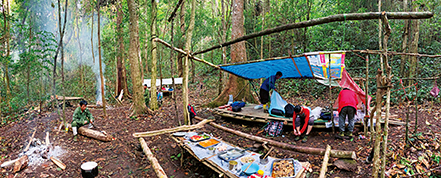
A camp site in Nam Ha National Protected Area. (LI GUOGANG)
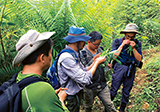
The scientific expedition team identifies plant specimens. (SONG LIANG)
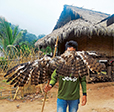
A Lao villager displays the trophy wings of a crested serpent eagle that was hunted. (ZHANG MINGXIA)

Members of the scientific expedition team observe fish specimens. (GAN ZHONGLI)
BIODIVERSITY IN THE KARST REGION OF SOUTHEAST ASIA AND ITS CONSERVATION
The forgotten limestone ecosystems of Southeast Asia
By Alice C. Hughes
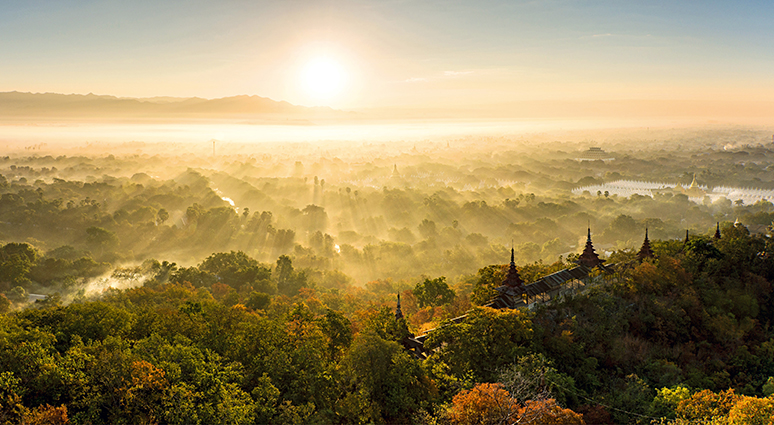
A view of Mandalay, Myanmar. (SANTI SUKARNJANAPRAI)
When we think about biodiversity in Southeast Asia, we generally think about the verdant forests. However, one special part of the Southeast Asian landscape is frequently forgotten: the limestone hills that make up around 800,000 square kilometers of Southeast Asia and host a suite of rare and endemic species unable to survive anywhere else.
Most of the species that inhabit these limestone hills are so specialist that they may only occur on a single limestone outcrop, just one hill. These species include unique orchids, begonias, gesneriads, snails so small they could fit in the eye of a needle, and geckos so beautiful that entire populations of a species are often collected to extinction for the pet trade when the species is first described by scientists. Given the burgeoning demand for cement across Southeast Asia, many species are at risk of going extinct before they are even scientifically described.
The majority of the species that depend on these limestone hills are still unknown. In fact, 90 percent of cave invertebrates in China estimated as undescribed, and probably similar percentage of other cave and karst dependent species, remain undiscovered across the region. A single karst hill can host 12 or more site-endemic species, found only on that one site, so losing a single karst can mean the extinction of the species dependent upon that system.
This wide array of fascinating and fragile organisms together form ecosystems like no other, including even each other. The species which live in karsts are unique, and their isolation makes them like remote islands in many ways, meaning their species are frequently unique; but the diversity is higher than the equivalent island systems—as they can host both specialist and non-specialist species.
Karst Specialists: What Makes Them Special
One of our major activities is surveying bats across the region. Bats are an incredible group of species, making up the second largest group of mammals at over 1,400 species, but only around 50 percent of species present have even been described in Southeast Asia. Our research on bats actually spans over 12 years, and the whole of the Southeast Asian region, though our main focus now is in line with our other karst projects and we have already measured thousands of bats as part of the study.
Our research includes many aspects of bat behavior from diet selection, migratory patterns to population genetics. Just within our institute (Xishuangbanna Tropical Botanical Garden), we have listed 42 species to date. These species include new records for China such as the first record of Kerivoula kachinensis, and interesting observations in rare species like the Harlequin bat and possible migratory behavior in a whole suite of species. Some of these bats may be migrating thousands of kilometers, but we are still collecting the data to see what is moving where so we can better understand their movements using isotopes in their fur to see where they may have travelled across the year.
Bats are often featured as movie monsters, yet many species are important as pollinators, seed dispersers and for pest control, and they have a huge suite of fascinating adaptations for their habitats. This means that though some species may migrate thousands of kilometers, others may be restricted to a single karst, unable to fly outside the forest due to adaptations which make flight expensive and calls only useful over short distances. Every part of a bat is adapted to its habitat and diet, with species like Thailand’s “bumblebee bat” (Craseonycteris thonglongyai, the world’s smallest mammal) which only uses caves with a very particular type of limestone, probably because of the way this limestone erodes; as this determines the presence of structures that different species of bats roost in.
Another group we have been focusing on are the karst geckos, including the true cave geckos (Cyrtodactylus and Goniurosaurus) and other species which can also show endemism on karsts like Hemiphyllodactylus. Karst geckos are a very charismatic group of animals which show high site-specific endemism to karst hills, meaning that each expedition reveals new species; we are currently working to describe potentially eight or more new species from our last expedition. Like for many cave endemic species, we are only starting to understand the patterns of diversity and endemism in this group, and we hope our study will shed new light on the processes of karst colonization and enable their conservation into the future.
The diversity of life forms inhabiting karsts demonstrates how valuable these habitats are. Cave fish, for instance, are often highly-modified relatives of river fish. In colonizing karst landscapes, they often lose the ability to see (frequently losing their eyes altogether) and lose all pigment, becoming a ghostly pink-white color. These species can be found in the depths of caves far from the outside world, largely living off the detritus brought in by the bats, and the other species which depend upon it. Like other cave-dependent species, cave fish show very high levels of endemism. We still know very little about their distribution over the region, so our studies will provide new insights into how different types of organisms may colonize karsts in different ways.
Surveying the immense diversity of karst invertebrates requires collaboration, and we are presently working with global experts on the elongated Trechine cave beetles, as well as centipedes and millipedes, while outside the caves we focus on karst microsnails, which can have as many as 100 species from a single site! The vast majority of these cave-dependent species have never been scientifically described, meaning potentially hundreds of new species which would remain unknown and unprotected without our efforts.
Amazingly, despite their love of sunlight, some plants like Urticaceae and Begonia are frequently found in even the lowest of light levels in caves. Though the mechanisms that urticaceae are still unknown, begonia uses a system a little like the light reflectors often used on roads to reflect light back into their cells to use again for photosynthesis. This strategy makes the leaves glitter blue-green in torch light. These and other plant species also depend on karsts for survival, showing just as high levels of diversity and endemism as other cave-dependent groups do. Like other cave and karst dependent species, these species are often isolated to only a small area, and like karst geckos, they are vulnerable both to the loss of habitat and targeted collection.
After years of work, we are beginning to understand these complex, hidden ecosystems, but the high diversity and the great threats they face make further research all the more important. With so many undescribed species, this is a daunting, but worthwhile, task. If we do not act to preserve these systems then we will lose a vast wealth of unique species without even knowing it.
Myanmar and Its Karsts
Myanmar is an incredibly diverse country, yet we are still only scratching the surface for much of its biodiversity. The challenging political situation means the country was largely closed to biologists for many years, yet with potential development to come we now face the urgent task of prioritizing areas for protection before they face development.
Many of the sites we inventoried had never been previously surveyed, and further work will be needed to completely inventory the species in each of them. Our work included sites across Myanmar, with one site only accessible using a huge rock transportation lorry followed by a steep hike. That particular cave was so full of bats that every surface was caked in Guano, and unlike most caves, this one had so many bats that the walls actually crawled with ticks, yet we recorded new locations for a number of species. On emerging from this cave, we were greeted by several soldiers and police, who were there probably more due to curiosity than security. They seemed surprised to see our all-female team of four nationalities emerging from the ground and probably appearing like we had spent several years under it.
Sadly, from a biological perspective, not all the caves we visited were so little accessed, and many sites had already been converted into temples or tourist caves. Though some of these only opened some areas of the cave, others projected light onto almost every inch of wall and floor and more closely resembled casinos than the caves we (or bats) preferred to visit. In these caves, the number of remaining species was hugely variable, but many contained only the most tolerant and generalist of species, and some had no bats at all. Yet, when done well (i.e. leaving some areas undisturbed and only lighting areas when people walk by), tourism can provide useful revenue for preserving cave sites and their biodiversity.
The caves and karsts of Myanmar took us across the country, providing many insights into a region with an incredible history for its people as well as its other species. Standing near the top of a steep hill in the mouth of a narrow cave, we watched a train steam through the valley below, which reminded me of the challenging circumstances under which many of the region’s railways were laid and the lives lost to build them. Yet some of our sites made us reflect on an earlier time in human history, such as the Padal in caves. These caves lie nestled at the end of an island in a reservoir, surrounded by the towering Nwalabo karst mountains, which remain largely unexplored and include cave paintings of over 15,000 years old, though deposits indicate that these, like so many caves, have been an important part of human history for over 65,000 years.
In Myanmar, like the rest of the region, we still have so much to learn, as many of the sites we visited hosted their own unique species and many additional sites remain entirely unchecked. Our work is allowing us to begin to understand patterns of diversity for at least some species.
The karsts we survey also vary hugely in their shape and size, from the extensive and rugged karst landscapes of Ha Giang and Lao Cai in Vietnam (unrecognized centers of diversity and endemism for the whole of Southeast Asia), and the famous karst islands of Cat Ba and Halong bay (which despite their fame are still understudied, and have many new species to describe), to isolated karsts across the region. None have complete inventories, and outside Vietnam few have any form of protection, and almost all need better protection and more research.
About the author Alice C. Hughes is a research fellow at the Xishuangbanna Tropical Botanical Garden of Chinese Academy of Sciences and a council member of the Association for Tropical Biology and Conservation from 2017-2019.
90%
In fact, 90 percent of cave invertebrates in China estimated as undescribed, and probably similar percentage of other cave and karst dependent species, remain undiscovered across the region.
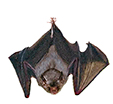
The bumblebee bat, the world’s smallest mammal. (YUSHI OSAWA)
1,400 mammals 50%
Bats are an incredible group of species, the second largest group of more than 1,400 mammals, but only about 50% of them have been described in Southeast Asia.
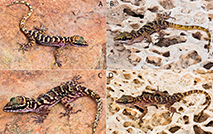
Color pattern variation in Cyrtodactylus chrysopylos from the Padalin Cave, Shan State, Myanmar. (PLAZI.ORG) A. Adult male B. Adult female C. Adult female D. Adult male

The Padalin Cave in Shan State, Myanmar. (PLAZI.ORG)
BACK FROM THE BRINK
Once thought extinct, the population of the crested ibis is growing after four decades of conservation efforts in China
By Zuo Lin

A foraging crested ibis. (VCG)
About 200 kilometers south of Xi’an, capital of southwest China’s Shaanxi Province, along the Hanjiang River in the Hanzhong Basin, is Yangxian County. Abundant rainfall brings lush vegetation by early summer, making the area attractive to the crested ibis (Nipponia nippon), a medium-sized, white-plumaged wading bird with bright red on its face, legs, and tip of bill. A slight tinge of orange can be spotted on their outstretched wings. Residents of the area have become familiar with the birds, and flocks of the ibis can frequently be found probing around for small fish and shrimp in rice paddies.
In years past, the crested ibis was common throughout Northeast Asia from Russia to China, Japan, and the Korean Peninsula. Because of habitat loss, its population declined rapidly in the 1970s. The species was thought extinct in the wild until an exciting discovery in May 1981. The last seven wild crested ibises in the world were found in Yangxian.
Decades of extensive conservation efforts since have saved the avian species from extinction. According to a June 2020 report from the Shaanxi Forestry and Grassland Administration, now there are more than 5,000 crested ibises worldwide, of which about 4,400 live in China—4,100 in Shaanxi. As a result, the status of the crested ibis has improved from “critically endangered” to “endangered” on the International Union for Conservation of Nature (IUCN) Red List of Threatened Species.
Tracking and Monitoring
At 55, farmer-turned-conservationist Liu Yi identifies himself as an “ibis herder.” He oversees captive breeding at the Shaanxi Hanzhong Crested Ibis National Nature Reserve, largely located in Yangxian. A short 30 years ago, his only exposure to the crested ibis was a poster promoting protection of the bird put up by the local government. “To be honest, I didn’t even recognize the Chinese character for ibis at the time,” Liu recalled.
Liu identified the turning point as the time nine birds landed in the trees in front of his house in the summer of 1990. Mistakenly called “red cranes” by local villagers at first, the birds left to search for food at dawn and returned at night to roost in the treetops. Soon after their arrival, two staff members of Yangxian monitoring station visited Liu’s home. They identified the birds as the crested ibis and spent the next two days in the village observing them.
Back then, only less than 20 crested ibis individuals were living in China. Feeling responsibility to protect the endangered species from being hunted, Liu joined a conservation team along with about 30 other villagers.
Members of the conservation team were tasked with tracking the wild crested ibises inhabiting a protected area in Yangxian and observing their behavior during feeding, breeding, nesting, and hatching, according to Liu. “At the time, our conservation efforts were primarily focused on tracking and monitoring birds in the wild,” he said. “We had to stay sharp-eyed and sharp-eared from dawn till dusk.”
Liu and his colleagues tried every possible means to track the birds. To follow wandering populations, they would work a relay using monoculars and walkie-talkies—the best equipment available at the time. During breeding season, they would erect a shack near the nest and spend about three months observing the mating pairs while protecting the nests from predators such as snakes. Thanks to several years of field surveys, the conservation team collected a wealth of first-hand information that has proved valuable for the study of the endangered bird species.
Members of the team were all part-timers hardly earning anything before a contract system was introduced in 1998 after a suggestion from Liu. Under the system, monitoring work was contracted to farmers-turned-rangers based near each nesting site in the county’s protected area. In 2001, a provincial-level wildlife reserve was established. As nesting sites in the reserve increased from a dozen to nearly 60, the rangers’ patrol area was expanded into neighboring counties. Four years later in 2005, the increasing crested ibis population helped the reserve gain state-level status as the Shaanxi Hanzhong Crested Ibis National Nature Reserve.
Today, the bird’s habitat within the reserve has increased from less than five square kilometers in 1981 to 15,000 square kilometers, covering 16 counties and districts in Hanzhong, Baoji, and Ankang cities. Monitoring equipment has also improved. Now, rangers drive motorcycles or cars to patrol remote regions. Satellite tracking and radio telemetry have replaced human eyes and ears.
Captive Breeding
After two years of tracking and monitoring the crested ibis in the wild, Liu’s excellent performance earned him a position in the reserve’s captive breeding program working with three researchers.
From the spring of 1992 to the spring of 1995, however, only limited progress was made. Three pairs of captive crested ibises bred just one or two nestlings each year before the three researchers left in 1996. Liu continued the demanding work and achieved encouraging results the same year.
A total of 11 chicks were hatched and eight survived. Lacking a university degree, Liu attributed his success to his diligence. Over the previous three years, he devoted meticulous attention to key indicators such as temperature and humidity, and often reflected on the differences and similarities of the researchers’ opinions. “Captive breeding is not particularly difficult technically,” Liu explained. “But you have to be really committed to everything you do.”
Duan Ying has been breeding the crested ibis in captivity for 23 years. She revealed that to avoid bird losses caused by personnel factors, all employees are required to commit to the position for the entire 70-plus-day breeding season.
“When we see a crested ibis get hurt, it’s painful.” Duan Ying said with a motherly tone. “After so many years, I still always put my work first regardless of what is going on at home. We treat these birds like our children. It breaks my heart to find that something bad has happened to them. They have remained my top priority for many years.”
Release into the Wild
Several years ago, while conducting a field survey, Duan found a crested ibis foraging for food in a river. “I noticed that the bird was looking at me, so I observed its leg band carefully with a telescope. Then I went back and checked our records, and it turned out it was one of the birds we had released into the wild.”
A return to nature is the best end-result for captive-bred crested ibises. When the bird population recovered from the brink of extinction, experimental release was launched to help ibises raised in captivity adapt to the natural environment. “The ultimate goal of the captive breeding program is to send the birds back into the wild,” Liu remarked.
Releases of captive-bred crested ibises have been organized by the State Forestry Administration of China since 2004. Individuals reintroduced to Yangxian in the first two years successfully settled in the wild. In May 2017, another 26 birds were released in Ningshan County, an area about 100 kilometers from Yangxian with a similar ecosystem. In April of the following year, a pair spawned three nestlings. Of the other 24 birds, three went missing, five were confirmed dead, six flew back to the captive breeding base, and 10 survived in the wild.
The range of reintroduction has continued to expand. Since 2013, 62 crested ibises were released in Tongchuan, 300 kilometers north of Yangxian, where they adapted well to the colder winter and grew a 100-strong population within seven years. The first release outside Shaanxi, the captive population’s base, was carried out in October 2013. A total of 34 birds were released 800 kilometers away in Luoshan County in neighboring Henan Province, the largest single release of the bird ever.
When the population of an endangered bird species rises steadily, problems such as inbreeding can arise. “Recently, many chicks were born with defects due to a loss of genetic diversity,” said Yu Xiaoguang, a professor at the School of Life Sciences of Shaanxi Normal University. “The recovering population is primarily made up of offspring of the captive-bred pairs from Yangxian. Historically, certain crested ibis populations migrated to warmer places for winters, but the current population is unable to survive extreme cold, so we need to figure out how to train them.”
The crested ibis is sensitive to environmental challenges. To protect their natural habitats, extensive efforts have been made by the government of Yangxian. Four days after the discovery of the seven remaining birds in 1981, emergency regulations were enacted to prohibit hunting in habitats, logging around nesting areas, usage of agrochemicals at feeding sites, and land reclamation and shooting around breeding sites.
Decades of such conservation actions have also helped improve the county’s natural environment. Several captive-bred ibises from Yangxian were sent to Japan and South Korea as diplomatic gifts.
An ornithologist at the Institute of Zoology under the Chinese Academy of Sciences, Liu Yinzeng was one of the five researchers to discover the last seven wild crested ibises in Yangxian in 1981. He noted that the urbanization of Yangxian has led to a reduction of rice paddies in the countryside, which means a loss of feeding sites for the species. He believes the biggest issue now is determining how to preserve their natural habitats while promoting urban development.
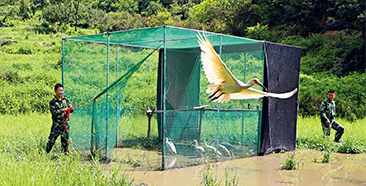
A captive-bred crested ibis is being released.
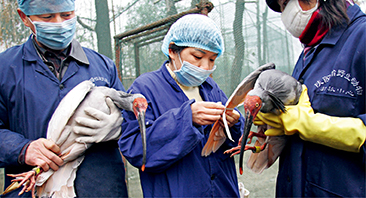
On March 8, 2007, a crested ibis is tagged before being transported, together with 19 other birds, to a reintroduction base for experimental release in Ningshan County, southwest China’s Shaanxi Province. (XINHUA)
L0039.T001.JPG
According to a June 2020 report from the Shaanxi Forestry and Grassland Administration, now there are more than 5,000 crested ibises worldwide, of which about 4,400 live in China—4,100 in Shaanxi.
PROTECTING ENDANGERED PLANTS
Preserving life and hope along the Yangtze River
By Wang Xiang
The Endangered Plants Institute of the China Three Gorges Corporation (hereinafter the “Plants Institute”) is situated in a green stretch upstream of the right bank of the Three Gorges Project. Every spring, a special spring plowing occurs there. After 10 years of efforts, 1,006 species of endangered plants from the Yangtze River area grow there. The people doing the plowing are not farmers, but scientists from the Plants Institute.
When construction of the Three Gorges Dam began, some experts warned that 560 species of terrestrial plants would be affected. Among the endangered species of plants distributed along the banks of the Yangtze River, Myricaria laxiflora, a shrub, and Adiantum reniforme, a fossil fern, were identified as at risk of catastrophic destruction. To save the precious plants, the China Three Gorges Corporation (CTG) founded the Three Gorges Nursery Center in 2007, the predecessor of the Plants Institute. The institute focuses on the ex-situ conservation, transplant, tissue culture and molecular genetics of endangered plants.
Hard and Hazardous Research
Huang Guiyun, deputy director of the Plants Institute, began studying M. laxiflora with a team as early as 2000 and gained considerable first-hand information about the shrub species.
“The field research was hard and hazardous,” said Huang. “We had to carry equipment and luggage weighing about 30 to 40 kilograms deep into the mountains and stay there for half a year. We had to navigate all sorts of difficulties and dangers including walking through dense forest, subsisting on instant food, drinking river water, sleeping in tents, and avoiding poisonous snakes, insect bites, and blood-sucking leeches.” Huang asserted that no one could have completed the mission without passion for the cause.
In a field investigation, Huang discovered the D. involucrate, an endangered dove-tree species under national first-level protection, on a cliff over 2,000 meters high. “We had to protect it from landslides,” she said. The researchers set up tents atop the mountain and rappelled down to observe and record its growth. To save the plant from destruction in a landslide, they piled a protective shield of rocks on the cliff and fixed it with thick ropes. The effort has continued for two years.
Endangered plant such as M. laxiflora and D. involucrate can grow in every corner of the Yangtze River basin, including places that can be extremely dangerous for researchers. Huang once stepped on a loose rock and fell when doing research. Fortunately, she was saved by a tree branch. “It took more than 10 hours for the local people to get me down from the mountain,” she recalled. Huang suffered a broken ankle in the incident.
New Home Sweet Home
“We continued researching M. laxiflora for over three years before moving them to a new home.” Huang Guiyun not only transferred the plants and surrounding vegetation, but also brought back habitat soil to make sure the plants would be viable in their new home. “We didn’t dare move every plant we could find all at once for fear they might all die. It took us 10 years to move the more than 800 plants to our institute.”
The scientists at the Plants Institute studied M. laxiflora by applying various vegetative reproduction methods including pruning and cloning. “We have cultivated 22,000 plants of M. laxiflora so far,” Huang said.
Huang also devoted considerable effort to moving and preserving D. involucrate. She visited Beijing to consult with experts at the Chinese Academy of Sciences before hammering out a phase-by-phase plan. The precious dove-tree was scheduled for relocation from an altitude of over 2,000 meters down to 1,000 meters, then to 500 meters, and finally to the Plants Institute. Each phase was planned for two years to give the trees time to acclimate to altitude and surroundings, which means the complete journey to their new home would take eight years. The scientists also kept monitoring the plants year-round.
To the scientists’ relief, the D. involucrate plants bloomed and presented beautiful, white dove-like flowers in just the second year of the move. After years of domestication techniques, the species was thriving in its new home at lower altitudes.
Flourishing Fossil Fern
Adiantum reniforme, or lotus-leaved maidenhair fern, is a rare species of great medicinal value and aesthetic merit. After many years of searching, Huang had located only about 200 plants of the fern on the lower Zigui River. “We consulted with relevant experts before moving them to the Plants Institute,” she said. “Petri dishes growing the fern seedlings were placed on shelves of the institute’s culture room.”
“A. reniforme goes dormant in winter and grows best in summer,” Huang explained. “We put seedlings in thermostatic rooms where constant temperature and humidity are maintained to ensure they grow well all the time and maintain metabolic activity. This helped us learn growth patterns. Now, we can get them to produce spores three to four times a year.”
The scientists took great care of every hard-won sporophyte. They recorded monitoring data every two hours and even slept in the lab. In 2019, some experts visited the institute and reported that these precious plants were all growing and reproducing well. “I worried the plants would be dying, but they are flourishing,” one joked.
“These plants are like our babies,” gushed Huang. “They don’t speak, but we need to read the information they present to us. If we give them what they need, they will grow, bloom, and provide everything they can for humans. Our work is rewarding for all involved.”
Modified to Multiply
Each summer, the water level of the Three Gorges Reservoir is lowered to 145 meters to make room for incoming floodwaters. As the dry season arrives after September, the reservoir’s water level rises to 175 meters. The change in the water level creates a so-called riparian zone, a 30-meter, non-vegetative buffer zone wrought with ecological damage.
During the natural migration of the M. laxiflora, the shrub species developed a unique growth pattern to adapt to the seasonal rise and fall of the Yangtze River waters. The plants become dormant when submerged in water in summer, and resume growth when the water recedes in winter. The pattern enabled the plants to endure floods and stay alive even when drowned in water, which makes it ideal for sand dune stabilization along banks.
In the riparian zone of the Three Gorges Reservoir, however, water rises in winter and falls in the summer. So, the scientists began testing methods to maintain their growth in summer conditions. “We planted them on land and applied many domestication measures to modify dormancy patterns,” explained Huang. Now, the M. laxiflora can “stay awake” in summer with a survival rate of over 90 percent. “This breakthrough filled some blanks in the study of plants in riparian zones. It is significant, because maintaining vegetation in riparian zones is a problem not only in the Three Gorges Dam but also in many other places around the world.
Today, over 3,000 modified M. laxiflora plants have been returned to their original home along the Yangtze River, marking the complete reconstruction of their life system. Valued for its effectiveness at soil conservation, more M. laxiflora plants are taking root in the broader area along the Yangtze River every day.
“I am just doing my best to preserve life and hope along the Yangtze River,” said Huang Guiyun.

The scientists check the growth of plants in petri dishes in the laboratory of the Endangered Plants Institute of the China Three Gorges Corporation. (HUANG ZHENGPING)
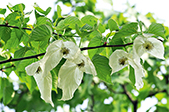
The dove-like flowers of D. involucrate.
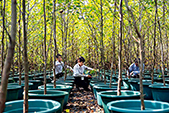
Scientists remove weeds from nursery pots holding Davidia involucrate in the nursery base of the Endangered Plants Institute of the China Three Gorges Corporation, on August 6, 2020. (XIANG HONGMEI)
SAVING A SPECIES
Conservation and breeding of the Chinese sturgeon in the Yangtze River
By Wang Fengjuan
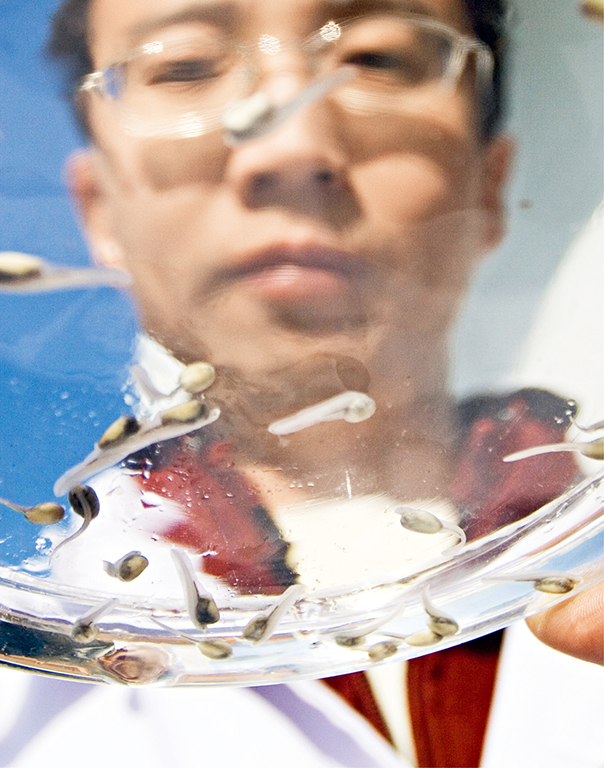
A technician examines newborn Chinese sturgeon “babies” at the Chinese Sturgeon Conservation and Release Center in Yichang, Hubei Province on November 27, 2008. (LI MING)
“Chinese sturgeons, safe journeys!”
“You’ve eaten well but now you’re on your own.”
“Keep going all the way to the sea, regardless of wind or rain!”
So went real-time online comments displayed during the livestream of an April 22 event in Yichang, central China’s Hubei Province, where 10,000 Chinese sturgeons (Acipenser sinensis), an endemic and critically endangered species, were released into the Yangtze River. When the sluice gate of the transparent water tank opened, the sturgeons were released from the environment in which they had been bred. Via a water slide, they entered the Yangtze River. This was the 62nd release by the Chinese Sturgeon Research Institute (CSRI) of the China Three Gorges Corporation.
“The event normally draws many spectators from among volunteers and residents along the river,” said Dr. Jiang Wei, director of the CSRI’s Hydrobiology Laboratory, “But because of the outbreak of COVID-19, this year’s event had no crowds. Instead, it was all online. The release still added to the stock of Chinese sturgeons in the natural environment all the same.” Jiang has participated in this event for 10 consecutive years. He began studying conservation and monitoring of rare species of fish in the Yangtze River while still a doctoral student. As a researcher at the CSRI, he has mostly concentrated on monitoring and researching the natural population of the Chinese sturgeon.
For dozens of years, the CSRI has intensified its efforts to achieve scientific and technological breakthroughs in the conservation and breeding of endangered rare species of fish in the Yangtze River, including the Chinese sturgeon. Conservation efforts for the Chinese sturgeon were enacted by the government and relevant institutions in the 1980s. In 1984, the first generation of artificially-bred sturgeons was released. Since then, the annual event has continued to draw participation of people from all walks of life.
Yangtze River Strains
The Yangtze River is considered the mother river of the Chinese nation. It originates from the Tanggula Mountains in western China’s Qinghai Province and flows through 11 provinces and municipalities before reaching the East China Sea. It ranks near the top of rivers globally in terms of aquatic life. The Yangtze hosts more than 4,300 species of aquatic life including 430 species of fish, 170 of which are unique to it.
The Chinese sturgeon is one of the oldest vertebrates on Earth with important ecological and scientific research value. Its origin can be traced back 140 million years to the age of dinosaurs. It’s one of the largest, longest-living and most sophisticated species of fish in the Yangtze River. After hatching in the upper reaches of the river, juveniles swim downstream into the sea to mature. They stay for more than 10 years to mature sexually before finally swimming upstream back to their breeding ground to spawn the next generation. They then return to the sea again. Since the 1980s, environmental changes, overfishing, water pollution, and other adverse factors have caused a steep decline in the natural population of the Chinese sturgeon. In 1988, it was listed as a first-class national protected animal by the Chinese government.
Of the 27 species of sturgeons worldwide, 23 are endangered, and 17 are listed by the International Union for Conservation of Nature and Natural Resources (IUCN) as critically endangered. In 2009, the Chinese sturgeon was listed by the IUCN as “extremely endangered.” In 2007, the white dolphin (Lipotes vexillifer), a Yangtze River freshwater cetacea known as the “aquatic panda,” was declared functionally extinct. Dr. Du Hejun, another researcher at CSRI, previously worked at the Institute of Hydrobiology of the Chinese Academy of Sciences, where he witnessed Qi Qi, the last male white dolphin, fail to find a mating partner, which led to the functional extinction of its species. In 2019, the Yangtze River paddlefish (Psephurus gladius), a ferocious fish known as the “king of freshwater fish in China,” was also declared extinct.
The functional extinction of Lipotes vexillifer and Psephurus gladius were stirring milestones for the Yangtze River.
In addition to the Chinese sturgeon, surviving flagship species in the Yangtze River ecosystem include Dabry’s sturgeon (Acipenser dabryanus Dumeril), Yangtze finless porpoise (Neophocaena asiaeorientalis), and others. Are they too destined for extinction?
“The causes of extinction can be quite complicated,” commented Jiang. “There’s nothing we can do for those that are gone. All we can do is try our best to preserve surviving endangered species.”
“Since the 1980s, our predecessors have been doing a lot to save the Chinese sturgeon,” Jiang continued. “While developing four world-class hydroelectric stations on the Yangtze River, the Three Gorges Corporation carried out a series of activities related to conservation of rare species of fish including scientific research, artificial breeding, and adding to the wild population. Since 1984, the CSRI has released more than 5.03 million Chinese sturgeons and 28,000 second filial generation Chinese sturgeons into the Yangtze River. Life in the natural environment will be difficult for released sturgeons. They must swim long distances and search for food on their own while avoiding hazards like fishing nets and propellers. And it takes a long time for them to sexually mature. That’s why so few have returned to Gezhouba Dam to breed. During the months of upstream migration, they do not eat. So, they have to be physically prepared for the arduous task. Individuals with good health, excellent germplasm, and diverse genes are more likely to survive. Smaller individuals are more likely to face pressure in the wild and have meager prospects reaching maturity.”
Homecoming
In the 1980s, when the Gezhouba Dam was built on the Yangtze River, migrating Chinese sturgeons gathered near the dam to form a new spawning ground. The spawning period of the Chinese sturgeon in the wild is from October to November every year.
November 24, 2016 was a big day for Jiang. That morning, he and his colleagues were searching for sturgeon eggs on the river when they noticed some charcoal gray particles in a net about 400 meters from the dam.
“Those are sturgeon eggs!” Jiang exclaimed. “We found them at last!” They took some back to their laboratory for incubation. Over the following week, they succeeded in collecting more eggs.
“Some experts thought the eggs might contain hybrid sturgeons,” said Jiang. “But our studies confirmed they were genuine wild Chinese sturgeon eggs. That meant that the wild Chinese sturgeon population was surviving tenaciously.
“The wild Chinese sturgeon eggs were hatched with artificial insemination and spawned a first and second filial generation of Chinese sturgeons. The second generation were the grandchildren of wild sturgeons. All individuals of the three generations are first-class nationally protected animals in China.” In 2009, his institute succeeded in artificially breeding the first individual of the second filial generation Chinese sturgeon. Since then, they have succeeded in more attempts at building an artificial Chinese sturgeon breeding system.
The release of artificially-bred sturgeons will undoubtedly add to the sturgeon population in the wild. A month before a release, the CSRI selects healthy and well-fed juveniles and cultures them in a simulated natural environment with flowing natural water and food to familiarize them with the big river. During this period, sampling inspections such as germplasm identification, fish quarantine, and biological physical examination are carried out for files.
According to Jiang, the group of Chinese sturgeons released this year was the largest yet. It was also the most diverse, with a combination of fry, fingerlings, and adults born from 2009 to 2019, including 10 males born in 2009. This diversity can add to the various age groups of sturgeons in the wild. The male individuals are expected to adjust the gender imbalance among sturgeons in the natural environment.
Tracking for Conservation
It’s impossible to locate the released fish in water with satellite positioning, so how are they tracked?
At present, four methods are used to track released sturgeons: PIT tagging, sonar tagging, T-shape tagging, and DNA tagging. With all of them in concert, released fish can be tracked throughout the entire river. When a tag is within the range of a scanner, it can identify the individual. So far, an 1,800-km long tracking system has been built to cover the middle and lower reaches of the Yangtze River. It is the most far-reaching and comprehensive system of its kind in China now.
The tracking at such large scale began in 2014. Tracking data from 2019 showed that 73.3 percent of released individuals had survived the length of the river and reached the sea.
“Sturgeons’ migration is a fairly long process,” explained Jiang. “Some individuals swim all the way downstream to the sea, while others may swim sideways into tributary lakes such as Dongting and Poyang before they return to the main stream. The tracking of those released this year is ongoing.”
Jiang and his team attached tags to the released sturgeons to track them long-term. The main purpose of the tracking is to identify wild stock from artificially-bred stocks for evaluation of the releases.
Jiang thinks the long life cycle of the Chinese sturgeon is one of the problems with conservation because it takes more than 12 years for the fish to become mature enough to breed in the upper reaches of the river. It’s impossible for the species to rebuild its population as quickly as more common species can. As a species at the upper end of the biological chain, it faces greater difficulty recovering in the declining water environment with fewer aquatic organisms. Since 2011, the Three Gorges Project has carried out experiments in biodiversity conservation for nine straight years. For example, they built artificial flood peaks to create better conditions for breeding of bluefish, grass carp, silver carp, and bighead carp, the four major species in the Yangtze River.
“Stock of the river’s four major species has declined more than 90 percent since the 1950s,” said Jiang. “But the population is finally recovering thanks to conservation efforts and fishing bans. Since January 1, 2020, fishing in the 332 nature reserves and aquatic germplasm conservation areas in the Yangtze River Basin has been completely banned. Starting January 1, 2021, fishing in the Yangtze River main stream and major tributaries will be suspended for 10 years.
“More importantly, since implementation of policy to protect and build the ecological environment of the river, the conditions have continuously improved.”
In recent years, President Xi Jinping inspected the Yangtze River Economic Belt several times and called for all-out efforts to protect the waterway. “We must not allow the ecological environment of the Yangtze River to continue deteriorating in the hands of our generation, and we must leave our descendants a clean and beautiful Yangtze River,” said the President at a seminar on promoting the development of the Yangtze River Economic Belt in Wuhan, Hubei Province, in 2018.
It has also been encouraging that residents along the river have gradually improved awareness of Chinese sturgeon conservation. Jiang noted that when they first started installing tag signal scanners on fishing boats and wharves, many people did not have any idea about the species or the importance of its conservation. Some people didn’t want their equipment installed. Nowadays, however, improved awareness has motivated residents to enthusiastically cooperate with the efforts.
“Everyone can help protect the ecological diversity of the Yangtze River just by doing things like disposing of trash properly, stopping fishing, and avoiding discharging sewage into the river,” said Jiang.
After they complete tracking the sturgeons released this year, Jiang and his team intend to analyze released sturgeons after they reach the sea to better assess the situation in the wild.

140 million years The Chinese sturgeon is one of the oldest vertebrates on Earth, and its origin can be traced back 140 million years to the age of dinosaurs.
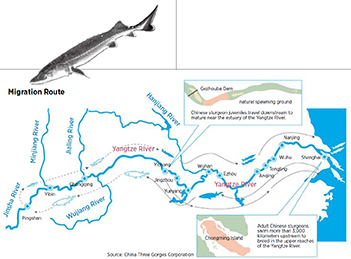

Technicians check on Chinese sturgeons at the Three Gorges Rare Fish Species Conservation Center in Yichang, Hubei Province, on August 7, 2020. (VCG)

Ten thousand second filial generation Chinese sturgeons are released into the Yangtze River in Yichang, Hubei Province, on April 22, 2020. (XIAO JIAFA)
FOR NATURE’S SAKE
Photographer & environmentalist Luo Hong tells stories with his camera
By Wang Fengjuan

Luo Hong observes an adorable penguin cub waddling towards its mother near the South Pole, November 2014.
Luo Hong Art Museum celebrated its fourth anniversary on August 9 after receiving more than 30 million visitors. Located in the eastern suburbs of Beijing, the museum features exhibition halls surrounded by a garden with stunning rocks and uniquely-shaped pines towering over a lake filled with swans and fish.
“We created the landscaping during the epidemic,” museum owner Luo Hong revealed, pointing to pines on the “islet” at the heart of the lake. “We wanted to replicate attractive natural scenes here at the museum to nourish every soul seeking a respite from urban hubbub.”
Normally, Luo travels to the African grasslands two or three times in the first half of the year, but the COVID-19 outbreak has prevented any traveling this year so far. “Staying home has been fine,” he said. “I’ve had plenty of time to sort my pictures from over the years.” For decades he has sought to capture nature’s most profound beauty to inspire kindness in people’s hearts.
Freezing Nature’s Beauty
“Just push a button, and an amazing moment will be etched into eternity,” beamed the nature photographer. Born in 1967 in southwest China’s Sichuan Province, Luo became enamored with cameras as a child. After graduating from high school, he left his mountainous hometown to make a living while chasing photography dreams. He founded Holiland, which is now a globally-known bakery chain, and his devotion to photography and environmental protection has persisted for 25 years.
Luo was originally attracted to natural landscapes, but during a 2001 Africa tour, his preference began shifting to wildlife. “That was my first trip to South Africa,” he said. “There, for the first time in my life, I experienced how close man could be with wild animals and Mother Nature. I realized that nature could only be complete with biodiversity. I found an overwhelming feeling of amazement that I had never felt before, and I wanted to preserve it forever with my lens.”
While in nature, Luo Hong feels calm and merges himself into the environment to inject more life into his photography. His images include not only stunning landscapes on the vast African continent but also breathtaking scenes of wildlife such as lions frolicking in Masai Mara National Reserve, a mother cheetah playing with her son under the first rays of dawn, massive migrations of wild animals, herds of African elephants kicking up dust, thousands of flamingos shimmering over Lake Bogoria, and emperor penguins waddling adorably.
Harmony between man and nature fuels the eternal flames of life, according to Luo Hong. “Nature’s beauty sparked my commitment to environmental protection and increasing knowledge about our home planet has made me more passionate about cherishing Mother Nature and respecting each creature on Earth. I see each of my photographic missions a love letter to life.” He believes that is why his photos often resonate so well with the public.
Luo feels empowered by nature, which inspires him to dedicate energy and enthusiasm to wildlife photography. At Lake Nakuru Game Park in Kenya, he set out before sunrise for four consecutive days to shoot rosy flocks of flamingos. In the Masai Mara National Reserve, he perched on rocks for two days running waiting for the spectacle of wildebeests crossing the river in massive herds. And to capture the most touching moments of emperor penguins, he worked for 12 hours straight in ice and snow.
Photographic Adventures
Luo’s deep love for nature has driven him to many places around the world. He has visited Africa 53 times, the South Pole twice, the Arctic Circle four times, South America four times, and North America four times to capture hundreds of thousands of photographs.
The latest exhibition at his art museum is devoted to photos he captured during his three most recent adventures to Africa. Among the first visitors to attend the exhibition after it opened on December 19, 2019 were former French President Francois Hollande, former Pakistani Prime Minister Shaukat Aziz, and former Thai Deputy Prime Minister Supachai Panitchpakdi.
When scenes of Luo pointing a camera from a helicopter were displayed in the promotional film, Mr. Hollande took a deep breath and grabbed Luo’s hands, reminding him to stay safe.
Field photography is often accompanied by danger, but Luo has been taking pictures in the wild for more than 20 years. “Passion prevails over fear,” he smiled. Without passion and perseverance, a field photographer will easily give up in the face of harsh weather conditions. Luo even survived a helicopter crash. Every time he encountered critical danger, he wondered whether that would be the time he couldn’t go home, but his worries then quickly dissolved and he would pack for the next excursion without hesitation.
“I hope my photographs help more people realize the importance of environmental protection because photography has become my tool to protect the environment—by offering my interpretations of nature,” he said, hoping to leave something of value behind for his offspring by using a camera.
To shoot the legendary lion duo of Masai Mara, Luo once ignored seven days of heavy rain and jumped on an all-terrain vehicle headed to the grassland upon arrival. But flooded roads prevented him from reaching deep into the grassland. Even worse, he came down with a fever after returning to the hotel. Concerned, the guide asked if he wanted to cancel making another attempt the next morning. Luo firmly replied that the plan would not be changed as long as he could still press the button.
After following the lion duo for more than three years, the photographer became their friend and even witnessed them fighting enemies together. He stresses that because the Blue Planet is a common home for all human beings, we should respect the lives of other creatures if we truly love our home. His friends found in nature also include flamingos on Lake Nakuru, wildebeests in Masai Mara, elephants on Kilimanjaro, and giraffes and zebras in Namibia, just to name a few.
Luo’s photographs have inspired many people’s love and respect for Mother Nature. A dentist who accepted a book of Luo’s swan photography as a thank-you gift for treatment confessed that many years ago on a hunting trip to the Inner Mongolian grassland, he killed a swan by a lake, and that the beauty of swans in Luo’s photographs triggered guilt over that experience. These days, the dentist is an active wildlife guardian.
For Future Kids
Everything beautiful on this planet can be fleeting, so we should never be lazy or leave things to chance, according to Luo. He still remembers his father’s words to him when he left home. His father said that regardless of his vocation, he must be true to his conscience, and that wherever he finds himself, he must try to bring happiness to everyone around him.
On June 5, 2006, to mark the World Environment Day, Luo Hong presented a solo photography exhibition upon an invitation from the United Nations Environment Programme (UNEP), which was the first ever solo photo exhibition at UNEP headquarters in Nairobi. Luo’s works on the ecology in western China and Africa caused a huge sensation. Afterwards, Luo established the Luo Hong Environment Foundation with UNEP, the first such individual foundation with the United Nations. So far, the foundation has sponsored six major projects: establishment of the Chinese website for UNEP, a protection program for Lake Nakuru flamingos in Kenya, training of global youth leaders on environmental protection, a program to eliminate human-elephant conflict in reserves in Zimbabwe and southern African countries, an environmental review of the 2008 Beijing Olympic Games, and a Chinese Children’s Painting Competition as part of the Chinese Children’s Environmental Education Programme.
Environmental awareness is now front-and-center in Luo’s heart. He sees the power of nature as ever-changing and the power of life as much stronger than anyone can imagine. He believes that is why the Planet Earth remains vibrant after surviving so much trauma for eons.
Luo has sponsored six rounds of the Chinese Children’s Painting Competition, which attracted some 23 million submissions in total. He even organized 120 first-prize winners to travel to UNEP headquarters in Nairobi to accept the awards and visit Masai Mara National Reserve and Lake Nakuru along the way.
“Just like my first trip to Africa, the children were excited to witness wild animals living in harmony with nature,” Luo recalled. The activity was intended to nudge the children closer to wild animals and Mother Nature.
After holding many photo exhibitions abroad, Luo decided to build his eponymous photography museum as a “resting place for art and soul,” to help to raise public awareness of the importance of environmental protection.
After six years of preparations and construction, Luo Hong Art Museum officially opened in 2016. It features three sections: Oriental Garden Landscapes, Luo Hong Photography Gallery, and Black Swan Cake Art Museum. Children under the age of 15 can visit the museum free of charge regardless of nationality because Luo knows the value of children to the future of nature. Luo hopes his museum is a place where children feel and understand the beauty of nature.
The day before the museum opened, Luo wrote in his blog: “I want to share my work with others so more people will cherish the beauty of Earth and develop respect and gratitude for the planet we call home.”
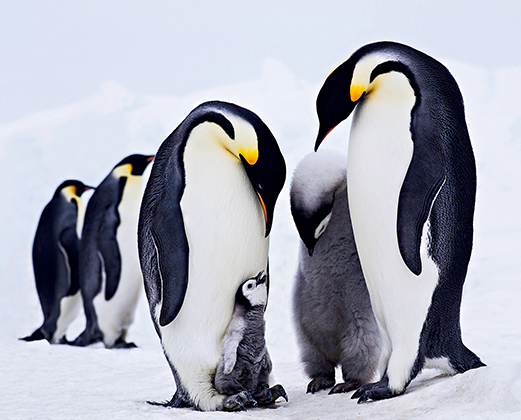
Penguins huddle together near the South Pole, November 2014. (LUO HONG)
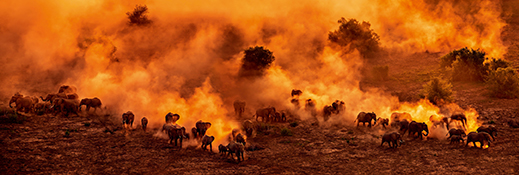
Light dazzles a herd of elephants in a five-minute spectacle in Kajiado, Kenya, May 2019. (LUO HONG)
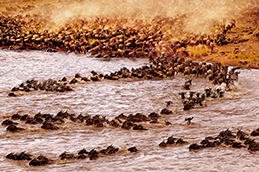
A herd of wildebeests crosses the Mara River, nearing the end of their migration from the Serengeti prairie in Tanzania to Masai Mara in Kenya, 2006. (LUO HONG)

A lion duo in Masai Mara, Kenya, May 2019. (LUO HONG)

Three giraffes against a setting sun in Etosha, Namibia, 2003. (LUO HONG)

A pair of swans set off by aquatic plants and other swans in Xinjiang, China, February 2012. (LUO HONG)


 Copy Reference
Copy Reference